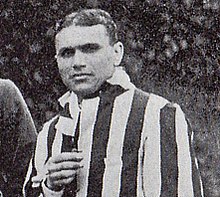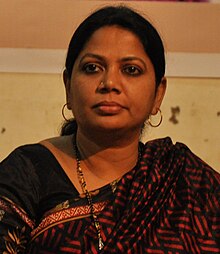Introduction


India, officially the Republic of India, is a country in South Asia. It is the seventh-largest country by area; the most populous country from June 2023 onwards; and since its independence in 1947, the world's most populous democracy. Bounded by the Indian Ocean on the south, the Arabian Sea on the southwest, and the Bay of Bengal on the southeast, it shares land borders with Pakistan to the west; China, Nepal, and Bhutan to the north; and Bangladesh and Myanmar to the east. In the Indian Ocean, India is near Sri Lanka and the Maldives; its Andaman and Nicobar Islands share a maritime border with Thailand, Myanmar, and Indonesia. (Full article...)
 Featured article – show another
Featured article – show another
-
Image 1
Tiruchirappalli (Tamil pronunciation: [ˈt̪iɾɯtːʃiɾapːaɭːi] ⓘ, formerly called Trichinopoly in English, also known as Tiruchi or Trichy), is a major tier II city in the Indian state of Tamil Nadu and the administrative headquarters of Tiruchirappalli district. The city is credited with being the best livable and the cleanest city of Tamil Nadu, as well as the fifth safest city for women in India. It is the fourth largest city as well as the fourth largest urban agglomeration in the state. Located 322 kilometres (200 mi) south of Chennai and 374 kilometres (232 mi) north of Kanyakumari, Tiruchirappalli sits almost at the geographic centre of Tamil Nadu state. The Cauvery Delta begins 16 kilometres (9.9 mi) west of the city where the Kaveri river splits into two, forming the island of Srirangam which is now incorporated into the Tiruchirappalli City Municipal Corporation. The city occupies an area of 167.23 square kilometres (64.57 sq mi) and had a population of 916,857 in 2011.
Tiruchirappalli's recorded history begins in the 3rd century BC, when it was under the rule of the Cholas. The city has also been ruled by the Pallavas, Pandyas, Vijayanagar Empire, Nayak Dynasty, the Carnatic state and the British. The most prominent historical monuments in Tiruchirappalli include the Rockfort at Teppakulam, the Ranganathaswamy temple at Srirangam dedicated to the reclining form of Hindu God Vishnu, and is also the largest functioning temple in the world, and the Jambukeswarar temple at Thiruvanaikaval, which is also the largest temple for the Hindu God Shiva in the world. The archaeologically important town of Uraiyur, capital of the Early Cholas, is now a neighbourhood in Tiruchirappalli. The city played a critical role in the Carnatic Wars (1746–1763) between the British and the French East India companies. (Full article...) -
Image 2
The 2000 Sri Lanka cyclone (IMD designation: BOB 06 JTWC designation: 04B) was the strongest tropical cyclone to strike Sri Lanka since 1978. The fourth tropical storm and the second severe cyclonic storm of the 2000 North Indian Ocean cyclone season, it developed from an area of disturbed weather on December 25, 2000. It moved westward, and quickly strengthened under favorable conditions to reach top wind speeds of 75 mph (121 km/h). The cyclone hit eastern Sri Lanka at peak strength, then weakened slightly while crossing the island before making landfall over southern India on December 28. The storm degenerated into a remnant low later that day, before merging with another trough on the next day.
The storm was the first cyclone over Sri Lanka with winds of at least hurricane strength since a cyclone of 1978 hit the island in the 1978 season, as well as the first tropical storm to hit the island since 1992. The storm was also the first December tropical cyclone of hurricane intensity in the Bay of Bengal since 1996. It produced heavy rainfall and strong winds, damaging or destroying tens of thousands of houses and leaving up to 500,000 homeless. At least nine people died as a result of the cyclone. (Full article...) -
Image 3Portrait by Rudolf Swoboda, 1888
Mohammed Abdul Karim (1863 — 20 April 1909), also known as "the Munshi", was an Indian attendant of Queen Victoria. He served her during the final fourteen years of her reign, gaining her maternal affection over that time.
Karim was born the son of a hospital assistant at Lalitpur, near Jhansi in British India. In 1887, the year of Victoria's Golden Jubilee, Karim was one of two Indians selected to become servants to the Queen. Victoria came to like him a great deal and gave him the title of "Munshi" ("clerk" or "teacher"). Victoria appointed him to be her Indian Secretary, showered him with honours, and obtained a land grant for him in India. (Full article...) -
Image 4

Darjeeling (/dɑːrˈdʒiːlɪŋ/, Nepali: [ˈdard͡ziliŋ], Bengali: [ˈdarˌdʒiliŋ]) is a city in the northernmost region of the Indian state of West Bengal. Located in the Eastern Himalayas, it has an average elevation of 2,045 metres (6,709 ft). To the west of Darjeeling lies the easternmost province of Nepal, to the east the Kingdom of Bhutan, to the north the Indian state of Sikkim, and farther north the Tibet Autonomous Region region of China. Bangladesh lies to the south and southeast, and most of the state of West Bengal lies to the south and southwest, connected to the Darjeeling region by a narrow tract. Kangchenjunga, the world's third-highest mountain, rises to the north and is prominently visible on clear days.
In the early 19th century, during East India Company rule in India, Darjeeling was identified as a potential summer retreat for British officials, soldiers and their families. The narrow mountain ridge was leased from the Kingdom of Sikkim, and eventually annexed to British India. Experimentation with growing tea on the slopes below Darjeeling was highly successful. Thousands of labourers were recruited chiefly from Nepal to clear the forests, build European-style cottages and work in the tea plantations. The widespread deforestation displaced the indigenous peoples. Residential schools were established in and around Darjeeling for the education of children of the domiciled British in India. By the late-19th century, a novel narrow-gauge mountain railway, the Darjeeling Himalayan Railway, was bringing summer residents into the town and carrying a freight of tea out for export to the world. After India's independence in 1947, as the British left Darjeeling, its cottages were purchased by wealthy Indians from the plains and its tea plantations by out-of-town Indian business owners and conglomerates. (Full article...) -
Image 5A female African bush elephant in Mikumi National Park, Tanzania
Elephants are the largest living land animals. Three living species are currently recognised: the African bush elephant (Loxodonta africana), the African forest elephant (L. cyclotis), and the Asian elephant (Elephas maximus). They are the only surviving members of the family Elephantidae and the order Proboscidea; extinct relatives include mammoths and mastodons. Distinctive features of elephants include a long proboscis called a trunk, tusks, large ear flaps, pillar-like legs, and tough but sensitive grey skin. The trunk is prehensile, bringing food and water to the mouth and grasping objects. Tusks, which are derived from the incisor teeth, serve both as weapons and as tools for moving objects and digging. The large ear flaps assist in maintaining a constant body temperature as well as in communication. African elephants have larger ears and concave backs, whereas Asian elephants have smaller ears and convex or level backs.
Elephants are scattered throughout sub-Saharan Africa, South Asia, and Southeast Asia and are found in different habitats, including savannahs, forests, deserts, and marshes. They are herbivorous, and they stay near water when it is accessible. They are considered to be keystone species, due to their impact on their environments. Elephants have a fission–fusion society, in which multiple family groups come together to socialise. Females (cows) tend to live in family groups, which can consist of one female with her calves or several related females with offspring. The leader of a female group, usually the oldest cow, is known as the matriarch. (Full article...) -
Image 6Gemini (/dʒɛminɪ/) is a 2002 Indian Tamil-language crime action film written and directed by Saran with Pon Elango as assistant director. This film was produced by AVM Productions. The film stars Vikram in the main lead role, while Kiran Rathod, Murali, Kalabhavan Mani, Vinu Chakravarthy, Manorama and Thennavan portray significant roles. Based on gang wars in Chennai, the film delves into the lives of outlaws and the roles the police and society play in their rehabilitation and acceptance.
In early 2001, rival gangsters "Vellai" Ravi and Chera reformed themselves with the patronage of a police officer. Saran was inspired by this incident and scripted a story based on it. Production began shortly afterwards in December the same year and was completed by March 2002. The film was shot mainly at the AVM Studios in Chennai, while two song sequences were filmed in Switzerland. The film had cinematography by A. Venkatesh and editing by Suresh Urs while the soundtrack was scored by Bharadwaj. (Full article...) -
Image 7Parinda (transl. Bird) is a 1989 Indian Hindi-language crime thriller film directed, produced and distributed by Vidhu Vinod Chopra. The film stars Jackie Shroff, Anil Kapoor, Nana Patekar and Madhuri Dixit. The story and scenario were written by Chopra, while Shiv Kumar Subramaniam and Imtiyaz Husain wrote the screenplay and dialogues, respectively. R. D. Burman composed the music and Khurshid Hallauri wrote the lyrics. Binod Pradhan served as the film's cinematographer and Renu Saluja was its editor.
Parinda follows Kishan (Shroff), who works for the underworld chieftain Anna (Patekar). Kishan's brother Karan (Kapoor) returns home after completing his studies in the United States. The two brothers are caught on different sides of a gang war after Karan decides to avenge his friend's death by Anna. (Full article...) -
Image 8Ahalya by Raja Ravi Varma (1848–1906)
In Hinduism, Ahalya (Sanskrit: अहल्या, IAST: Ahalyā) also spelt as Ahilya, is the wife of the sage Gautama Maharishi. Many Hindu scriptures describe her legend of seduction by the king of the gods Indra, her husband's curse for her infidelity, and her liberation from the curse by the god Rama.
Created by the god Brahma as the most beautiful woman, Ahalya was married to the much older Gautama. In the earliest full narrative, when Indra comes disguised as her husband, Ahalya sees through his disguise but nevertheless accepts his advances. Later sources often absolve her of all guilt, describing how she falls prey to Indra's trickery. In all narratives, Ahalya and Indra are cursed by Gautama. The curse varies from text to text, but almost all versions describe Rama as the eventual agent of her liberation and redemption. Although early texts describe how Ahalya must atone by undergoing severe penance while remaining invisible to the world and how she is purified by offering Rama hospitality, in the popular retelling developed over time, Ahalya is cursed to become a stone and regains her human form after she is brushed by Rama's foot. (Full article...) -
Image 9
Freida Selena Pinto (born 18 October 1984) is an Indian actress who has appeared mainly in American and British films. Born and raised in Mumbai, Maharashtra, she resolved at a young age to become an actress. As a student at St. Xavier's College, Mumbai she took part in amateur plays. After graduation, she briefly worked as a model and then as a television presenter.
Pinto rose to prominence with her film debut in the drama Slumdog Millionaire (2008), winning a SAG Award and earning a nomination for the BAFTA Award for Best Supporting Actress. She earned critical acclaim for her roles in Miral (2010), Trishna (2011), and Desert Dancer (2014). She also saw commercial success with the science fiction film Rise of the Planet of the Apes (2011), and the epic fantasy action film Immortals (2011). Pinto's other notable roles include You Will Meet a Tall Dark Stranger (2010), Love Sonia (2018), Hillbilly Elegy (2020), and Mr. Malcolm's List (2022). She also starred in the Showtime miniseries Guerrilla (2017), and had a recurring role in the Hulu series The Path (2018). (Full article...) -
Image 10Keechaka Vadham (transl. The Extermination of Keechaka) is an Indian silent film produced, directed, filmed and edited by R. Nataraja Mudaliar. The first film to have been made in South India, it was shot in five weeks at Nataraja Mudaliar's production house, India Film Company. As the members of the cast were Tamils, Keechaka Vadham is considered to be the first Tamil film. No print of it is known to have survived, making it a lost film.
The screenplay, written by C. Rangavadivelu, is based on an episode from the Virata Parva segment of the Hindu epic Mahabharata, focusing on Keechaka's attempts to woo Draupadi. The film stars Raju Mudaliar and Jeevarathnam as the central characters. (Full article...) -
Image 11

Territory of the Hoysalas and their neighbouring kingdoms in Western India, the Seuna Yadavas and Silharas in c. 1200[image reference needed]
Hoysala literature is the large body of literature in the Kannada and Sanskrit languages produced by the Hoysala Empire (1025–1343) in what is now southern India. The empire was established by Nripa Kama II, came into political prominence during the rule of King Vishnuvardhana (1108–1152), and declined gradually after its defeat by the Khalji dynasty invaders in 1311.
Kannada literature during this period consisted of writings relating to the socio-religious developments of the Jain and Veerashaiva faiths, and to a lesser extent that of the Vaishnava faith. The earliest well-known brahmin writers in Kannada were from the Hoysala court. While most of the courtly textual production was in Kannada, an important corpus of monastic Vaishnava literature relating to Dvaita (dualistic) philosophy was written by the renowned philosopher Madhvacharya in Sanskrit. (Full article...) -
Image 12Nil Battey Sannata (lit. 'Zero Divided by Zero Equals Nothing'; slang for "Good for Nothing"), released internationally as The New Classmate, is a 2015 Indian Hindi-language comedy drama film directed by Ashwiny Iyer Tiwari in her feature debut. Produced by Aanand L. Rai, Ajay Rai, and Alan McAlex under the banners of Colour Yellow Productions and JAR Pictures, the film was co-written by Iyer, Neeraj Singh, Pranjal Choudhary, and Nitesh Tiwari. Swara Bhaskar starred as Chanda Sahay, a high-school drop-out household maid and single mother of a sullen young girl named Apeksha, played by Riya Shukla. The film's theme is a person's right to dream and change their lives, irrespective of social status.
Released in India on 22 April 2016, Nil Battey Sannata was distributed by Eros International and garnered critical and audience acclaim. Reviewers praised most aspects of the production, especially its narrative and realism, and the performances of the cast, Bhaskar's in particular. At the 62nd Filmfare Awards, Iyer won the Filmfare Award for Best Debut Director, while Bhaskar and Shukla won the Screen Awards for Best Actress (Critics) and Best Child Artist respectively. The film did well at the box-office, collecting a total of around ₹69 million (US$800,000) during its entire theatrical run. The same year, the film was remade in Tamil as Amma Kanakku, with Iyer returning to direct. The following year, it was remade in Malayalam as Udaharanam Sujatha. (Full article...) -
Image 13The political history of medieval Karnataka spans the 4th to the 16th centuries in Karnataka region of India. The medieval era spans several periods of time from the earliest native kingdoms and imperialism; the successful domination of the Gangetic plains in northern India and rivalry with the empires of Tamilakam over the Vengi region; and the domination of the southern Deccan and consolidation against Muslim invasion. The origins of the rise of the Karnataka region as an independent power date back to the fourth-century birth of the Kadamba Dynasty of Banavasi which was the earliest of the native rulers to conduct administration in the native language of Kannada in addition to the official Sanskrit.
In the southern regions of Karnataka, the Western Gangas of Talakad were contemporaries of the Kadambas. The Kadambas and Gangas were followed by the imperial dynasties of the Badami Chalukya Empire, the Rashtrakuta Empire, the Western Chalukya Empire, the Hoysala Empire and the Vijayanagara Empire, all patronising the ancient Indic religions while showing tolerance to the new cultures arriving from the west of the subcontinent. The Muslim invasion of the Deccan resulted in the breaking away of the feudatory Sultanates in the 14th century. The rule of the Bahamani Sultanate of Bidar and the Bijapur Sultanate from the northern Deccan region caused a mingling of the ancient Hindu traditions with the nascent Islamic culture in the region. The hereditary ruling families and clans ably served the large empires and upheld the local culture and traditions. The fall of the Vijayanagara Empire in 1565 brought about a slow disintegration of Kannada-speaking regions into minor kingdoms that struggled to maintain autonomy in an age dominated by foreigners until unification and independence in 1947. (Full article...) -
Image 14
General Hastings Lionel "Pug" Ismay, 1st Baron Ismay (21 June 1887 – 17 December 1965) was a British politician, diplomat and general in the British Indian Army who was the first secretary general of NATO. He also was Winston Churchill's chief military assistant during the Second World War.
Ismay was born in Nainital, India, in 1887, and educated in the United Kingdom at Charterhouse School and the Royal Military College, Sandhurst. After Sandhurst, he joined the Indian Army as an officer of the 21st Prince Albert Victor's Own Cavalry. During the First World War, he served with the Camel Corps in British Somaliland, where he joined in the British fight against the "Mad Mullah", Mohammed Abdullah Hassan. In 1925, Ismay became an Assistant Secretary of the Committee of Imperial Defence (CID). After being promoted to the rank of colonel, he served as the military secretary for Lord Willingdon, the Viceroy of India, then returned to the CID as Deputy Secretary in 1936. (Full article...) -
Image 15
Muhammad Ali Jinnah (born Mahomedali Jinnahbhai; 25 December 1876 – 11 September 1948) was a barrister, politician, and the founder of Pakistan. Jinnah served as the leader of the All-India Muslim League from 1913 until the inception of Pakistan on 14 August 1947 and then as Pakistan's first governor-general until his death.
Born at Wazir Mansion in Karachi, Jinnah was trained as a barrister at Lincoln's Inn in London, England. Upon his return to India, he enrolled at the Bombay High Court, and took an interest in national politics, which eventually replaced his legal practice. Jinnah rose to prominence in the Indian National Congress in the first two decades of the 20th century. In these early years of his political career, Jinnah advocated Hindu–Muslim unity, helping to shape the 1916 Lucknow Pact between the Congress and the All-India Muslim League, in which Jinnah had also become prominent. Jinnah became a key leader in the All-India Home Rule League, and proposed a fourteen-point constitutional reform plan to safeguard the political rights of Muslims in the Indian subcontinent. In 1920, however, Jinnah resigned from the Congress when it agreed to follow a campaign of satyagraha, which he regarded as political anarchy. (Full article...) -
Image 16
The Marwari or Malani is a rare breed of horse from the Marwar (or Jodhpur) region of Rajasthan, in north-west India. It is closely related to the Kathiawari breed of the Kathiawar peninsula of Gujarat, with which it shares an unusual inward-curving shape of the ears. It is found in all equine colours, including piebald and skewbald. It is a hardy riding horse; it may exhibit a natural ambling gait.
The Rathores, traditional rulers of the Marwar region of western India, were the first to breed the Marwari. Beginning in the 12th century, they espoused strict breeding that promoted purity and hardiness. Used throughout history as a cavalry horse by the people of the Marwar region, the Marwari was noted for its loyalty and bravery in battle. The breed deteriorated in the 1930s, when poor management practices resulted in a reduction of the breeding stock, but today has regained some of its popularity. The Marwari is used for light draught and agricultural work, as well as riding and packing. In 1995, a breed society was formed for the Marwari horse in India. The exportation of Marwari horses was banned for decades, but between 2000 and 2006, a small number of exports were allowed. Since 2008, visas allowing temporary travel of Marwari horses outside India have been available in small numbers. Though they are rare they are becoming more popular outside of India due to their unique looks. (Full article...) -
Image 17

Territory of the Western Chalukyas (c. 1100 CE) in India (modern boundaries shown) and the empire's capital, Kalyani, in the modern Bidar district, Karnataka state, India
A large body of Western Chalukya literature in the Kannada language was produced during the reign of the Western Chalukya Empire (973–1200 CE) in what is now southern India. This dynasty, which ruled most of the western Deccan in South India, is sometimes called the Kalyani Chalukya dynasty after its royal capital at Kalyani (now Basavakalyan), and sometimes called the Later Chalukya dynasty for its theoretical relationship to the 6th-century Chalukya dynasty of Badami. For a brief period (1162–1183), the Kalachuris of Kalyani, a dynasty of kings who had earlier migrated to the Karnataka region from central India and served as vassals for several generations, exploited the growing weakness of their overlords and annexed the Kalyani. Around 1183, the last Chalukya scion, Someshvara IV, overthrew the Kalachuris to regain control of the royal city. But his efforts were in vain, as other prominent Chalukya vassals in the Deccan, the Hoysalas, the Kakatiyas and the Seunas destroyed the remnants of the Chalukya power.
Kannada literature from this period is usually categorised into the linguistic phase called Old-Kannada. It constituted the bulk of the Chalukya court's textual production and pertained mostly to writings relating to the socio-religious development of the Jain faith. The earliest well-known writers belonging to the Shaiva faith are also from this period. Under the patronage of Kalachuri King Bijjala II, whose prime minister was the well-known Kannada poet and social reformer Basavanna, a native form of poetic literature called Vachana literature (lit "utterance", "saying" or "sentence") proliferated. The beginnings of the Vachana poetic tradition in the Kannada-speaking region trace back to the early 11th century. Kannada literature written in the champu metre, composed of prose and verse, was popularised by the Chalukyan court poets. However, with the advent of the Veerashaiva (lit, "brave devotees of the god Shiva") religious movement in the mid-12th century, poets favoured the native tripadi (three-line verse composed of eleven ganas or prosodic units), hadugabba (song-poem) and free verse metres for their poems. (Full article...) -
Image 18Dilwale Dulhania Le Jayenge (transl. The Brave-Hearted Will Take the Bride), also known by the initialism DDLJ, is a 1995 Indian Hindi-language musical romance film written and directed by Aditya Chopra in his directorial debut and produced by his father Yash Chopra. Released on 20 October 1995, the film stars Shah Rukh Khan and Kajol as Raj and Simran, two young non-resident Indians, who fall in love during a vacation through Europe with their friends. Raj tries to win over Simran's family so the couple can marry, but Simran's father has long since promised her hand to his friend's son. The film was shot in India, London, and Switzerland, from September 1994 to August 1995.
With an estimated total gross of ₹102.5 crore (today's adjusted gross ₹524 crore), with ₹89 crore (today's adjusted gross ₹455 crore) earned in India and ₹13.50 crore (today's adjusted gross ₹69 crore) in overseas, the film was the highest-grossing Indian film of 1995 and one of the most successful Indian films in history. When adjusted for inflation, it is the second highest-grossing Indian film of the 1990s, behind Hum Aapke Hain Koun..! It won 10 Filmfare Awards—the most for a single film at that time—and the National Film Award for Best Popular Film Providing Wholesome Entertainment. Its soundtrack album became one of the most popular of the 1990s. (Full article...) -
Image 19
Shefali Shah (née Shetty; born 22 May 1973) is an Indian actress of film, television and theatre. Working primarily in independent Hindi films, she has received multiple local and foreign accolades for her performances. Shah's acting career started on the Gujarati stage before she debuted on television in 1993. After small parts on television and a brief stint with cinema in Rangeela (1995), she gained wider recognition in 1997 for her role in the popular series Hasratein. This was followed by lead roles in the TV series Kabhie Kabhie (1997) and Raahein (1999). A supporting role in the crime film Satya (1998) won her positive notice and a Filmfare Critics Award, and she soon shifted her focus to film acting starting with a lead role in the Gujarati drama Dariya Chhoru (1999).
Shah was selective about her roles through the following decades, resulting in intermittent film work, mostly in character parts and often to appreciation from critics. She appeared in the international co-production Monsoon Wedding (2001) and the mainstream comedy-drama Waqt: The Race Against Time (2005). In 2007, her portrayal of Kasturba Gandhi in the biographical drama Gandhi, My Father won her the Best Actress prize at the Tokyo International Film Festival, and she received the National Film Award for Best Supporting Actress for the drama film The Last Lear. Among her subsequent film roles, she played a leading part in Kucch Luv Jaisaa (2011) and was noted for her work in the social problem film Lakshmi (2014) and the ensemble drama Dil Dhadakne Do (2015). (Full article...) -
Image 20Portrait by Charles Dana Gibson, c. 1903
Margaret Ives Abbott (June 15, 1878 – June 10, 1955) was an American amateur golfer. She was the first American woman to win an Olympic event: the women's golf tournament at the 1900 Summer Olympics.
Born in Calcutta (now Kolkata), British Raj, in 1878, Abbott moved with her family to Chicago in 1884. She joined the Chicago Golf Club in Wheaton, Illinois, where she received coaching from Charles B. Macdonald and H. J. Whigham. In 1899, she traveled with her mother to Paris to study art. The following year, along with her mother, she signed up for a women's golf tournament without realizing that it was the second modern Olympics. Abbott won the tournament with a score of 47 strokes; her mother tied for seventh place. Abbott received a porcelain bowl as a prize. (Full article...) -
Image 21Loev (pronounced love) is a 2015 Indian romantic drama film written and directed by Sudhanshu Saria. It stars Dhruv Ganesh and Shiv Panditt as two friends who set off to the Western Ghats for a weekend trip and focuses on their complex emotional and sexual relationship. It was Ganesh's final film, as he died from tuberculosis before its release. Loev also features Siddharth Menon and Rishabh Chaddha in supporting roles. The film's title is a deliberate misspelling of the word "love".
Saria wrote Loev's script while he was working on the draft of the unreleased film I Am Here and drew heavily from his personal experiences. It was eventually picked up for production by Arfi Lamba and Katherine Suckale despite Saria's own doubts on its viability. Principal photography took place at Mahabaleshwar, in the Western Ghats in peninsular India, and at Mumbai. The film was shot in the summer of 2014 over the course of sixteen days by the cinematographer Sherri Kauk in 2K resolution. It relied on crowdfunding and cost-cutting measures; its budget was relatively low at US$1 million. (Full article...) -
Image 22
Sonam Kapoor Ahuja (pronounced [soːnəm kəˈpuːr]; born 9 June 1985) is a former Indian actress who worked in Hindi films. She has received several awards, including a National Film Award and a Filmfare Award. Kapoor appeared in Forbes India's Celebrity 100 list from 2012 to 2016.
Kapoor, the daughter of actor Anil Kapoor, began her career as an assistant director on filmmaker Sanjay Leela Bhansali's 2005 film Black. She made her acting debut in Bhansali's romantic drama Saawariya (2007), a box office flop, and had her first commercial success with the romantic comedy I Hate Luv Storys (2010). This was followed by a series of commercial failures and repetitive roles, which garnered her negative reviews. The 2013 box office hit Raanjhanaa marked a turning point in Kapoor's career, garnering her praise and Best Actress nominations at several award ceremonies. (Full article...) -
Image 23Procession march held on 21 February 1952 in Dhaka
The Bengali language movement was a political movement in East Bengal (modern-day Bangladesh) in 1952, advocating the recognition of the Bengali language as a co-lingua franca of the then-Dominion of Pakistan to allow its use in government affairs, the continuation of its use as a medium of education, its use in media, currency and stamps, and to maintain its writing in the Bengali alphabet / Bengali script
When the Dominion of Pakistan was formed after the separation of the Indian subcontinent in 1947, when the British left, it was composed of various ethnic and linguistic groups, with the geographically non-contiguous East Bengal province having a mainly ethnic Bengali population. In 1948, the Government of the Dominion of Pakistan ordained as part of Islamization of East Pakistan or East Bengal that Urdu will be the sole federal language, alternately Bengali writing in the Perso-Arabic script or Roman script (Romanisation of Bengali) or Arabic as the state language of the whole of Pakistan was also proposed, sparking extensive protests among the Bengali-speaking majority of East Bengal. Facing rising sectarian tensions and mass discontent with the new law, the government outlawed public meetings and rallies. The students of the University of Dhaka and other political activists defied the law and organised a protest on 21 February 1952. The movement reached its climax when police killed student demonstrators on that day. The deaths provoked widespread civil unrest. After years of conflict, the central government relented and granted official status to the Bengali language in 1956. (Full article...) -
Image 24Male in Serengeti National Park, Tanzania
The lion (Panthera leo) is a large cat of the genus Panthera, native to Africa and India. It has a muscular, broad-chested body; a short, rounded head; round ears; and a dark, hairy tuft at the tip of its tail. It is sexually dimorphic; adult male lions are larger than females and have a prominent mane. It is a social species, forming groups called prides. A lion's pride consists of a few adult males, related females, and cubs. Groups of female lions usually hunt together, preying mostly on medium-sized and large ungulates. The lion is an apex and keystone predator.
The lion inhabits grasslands, savannahs, and shrublands. It is usually more diurnal than other wild cats, but when persecuted, it adapts to being active at night and at twilight. During the Neolithic period, the lion ranged throughout Africa and Eurasia, from Southeast Europe to India, but it has been reduced to fragmented populations in sub-Saharan Africa and one population in western India. It has been listed as Vulnerable on the IUCN Red List since 1996 because populations in African countries have declined by about 43% since the early 1990s. Lion populations are untenable outside designated protected areas. Although the cause of the decline is not fully understood, habitat loss and conflicts with humans are the greatest causes for concern. (Full article...) -
Image 25
The red panda (Ailurus fulgens), also known as the lesser panda, is a small mammal native to the eastern Himalayas and southwestern China. It has dense reddish-brown fur with a black belly and legs, white-lined ears, a mostly white muzzle and a ringed tail. Its head-to-body length is 51–63.5 cm (20.1–25.0 in) with a 28–48.5 cm (11.0–19.1 in) tail, and it weighs between 3.2 and 15 kg (7.1 and 33.1 lb). It is well adapted to climbing due to its flexible joints and curved semi-retractile claws.
The red panda was formally described in 1825. The two currently recognised subspecies, the Himalayan and the Chinese red panda, genetically diverged about 250,000 years ago. The red panda's place on the evolutionary tree has been debated, but modern genetic evidence places it in close affinity with raccoons, weasels, and skunks. It is not closely related to the giant panda, which is a bear, though both possess elongated wrist bones or "false thumbs" used for grasping bamboo. The evolutionary lineage of the red panda (Ailuridae) stretches back around 25 to 18 million years ago, as indicated by extinct fossil relatives found in Eurasia and North America. (Full article...)
Selected pictures
-
Image 1A statue of the Hindu god Shiva as Nataraja, the Lord of Dance. In this form, Shiva performs his divine dance to destroy a weary universe and make preparations for the god Brahma to start the process of creation. A Telugu and Tamil concept, Shiva was first depicted as Nataraja in the famous Chola bronzes and sculptures of Chidambaram. The form is present in most Shiva temples in South India, and is the main deity in Chidambaram Temple, the foremost Shaivist temple.
-
Image 2Photograph: Jorge RoyanAn Indian merchant holding green chickpeas (Cicer arietinum). One of the earliest cultivated legumes, chickpeas are ingredients in a number of dishes around the world. India is the largest producer of this nutrient-dense food, accounting for 64% of global production in 2016.
-
Image 3Photo credit: Luc ViatourA fire breather in the "Jaipur Maharaja Brass Band" of India. Fire breathing, which is said to have originated in India, is the act of creating a large flame by spraying, with one's mouth, a flammable liquid upon an open flame. A number of legendary creatures are said to possess innate capabilities for fire breathing, most notably dragons.
-
Image 4Photograph: Muhammad Mahdi KarimThe Bara Imambara is an imambara complex in Lucknow, India. Built by Asaf-ud-Daula, Nawab of Awadh, in 1785, the building reflects a maturation of ornamented Mughal design (as seen in the Badshahi Mosque).
-
Image 5Photograph credit: Augustus BinuK. T. Thomas (born 30 January 1937) is a former judge of the Supreme Court of India, known for his strong opinions on Indian socio-political matters. He was selected as a district and sessions judge in 1977, and became a judge of the Kerala High Court in 1985. A decade later, he was appointed a judge of the Supreme Court, on which he served until retiring in 2002. He was awarded the Padma Bhushan by the Indian government in 2007 for services in the field of social affairs.
-
Image 6Photograph: Augustus BinuOdissi is an ancient classical dance that originated in the Hindu temples of Odisha, India. Historically, it has been performed predominantly by women, and expressed religious stories and spiritual ideas, particularly of Vaishnavism (Vishnu as Jagannath), but also of other traditions such as those related to Hindu gods Shiva and Surya, as well as Hindu goddesses (Shaktism). Modern Odissi productions by Indian artists have presented a diverse range of experimental ideas, culture fusion, themes and plays.
Odissi is learnt and performed as a composite of a basic dance motif called the Bhangas (symmetric body bends, stance). It involves the lower, mid, and upper body as three sources of perfecting expression and audience engagement with geometric symmetry and rhythmic musical resonance. -
Image 7Photograph credit: Jeevan JoseLeptosia nina, known as the psyche, is a species of butterfly in the family Pieridae (the sulphurs, yellows and whites), found in the Indian subcontinent, southeastern Asia, and Australia. It has a small wingspan of 2.5 to 5 cm (1 to 2 in). The upper side of the otherwise white forewing has a large, somewhat pear-shaped, black spot; this spot is also present on the underside which is scattered with greenish dots and speckles, sometimes arranged in bands. This L. nina butterfly was photographed in Kerala, India.
-
Image 8The mosque at the Taj Mahal complex in Agra, India. This red sandstone building, on the western side of the complex, faces the west side of the mausoleum. In the forefront is a howz, meant for ablution. On the eastern side of the complex is the jawab ("answer"), a mirror image of the mosque except for the missing mihrab and different floor pattern; this jawab was mainly intended for architectural balance. Both were constructed in 1643.
-
Image 9Photograph credit: Augustus BinuPomegranate juice is a beverage made from the fruit of the pomegranate. It is used in cooking both as a fresh juice and as a concentrated syrup. The fruit originated in the region extending from Iran to northern India and has been cultivated since ancient times. The fruit has a hard outer husk and a spongy mesocarp in which the seeds in their fleshy seedcoats are embedded. Pomegranate juice can be sweet or sour, but most fruits are moderate in taste. The juice has long been a popular drink in Europe and the Middle East, and is now widely distributed in the United States and Canada.
-
Image 10Photograph: Yann; edit: Jim CarterA view of the Taj Mahal from the south, featuring the Charbagh garden. The mausoleum complex also includes subsidiary tombs, waterworks infrastructure, the small town of Taj Ganji, and a "moonlight garden". Its origins and architecture have been extensively documented, covering both the circumstances of its commission and the cultural and historical influence of the Islamic Mughal Empire in India.
-
Image 11Photograph: Muhammad Mahdi KarimAn Indian palm squirrel (Funambulus palmarum) photographed in Bangalore, India. In India these squirrels are associated with the Hindu deity Rama, an avatar of Vishnu, and as such are not to be harmed. However, in Western Australia they are considered pests and at times targeted for eradication.
-
Image 12Photo: Augustus BinuRekha Raju performing Mohiniyattam, a classical dance form from Kerala, India. Believed to have originated in the 16th century CE, this dance form was popularized in the nineteenth century by Swathi Thirunal, the Maharaja of the state of Travancore, and Vadivelu, one of the Thanjavur Quartet. The dance, which has about 40 different movements, involves the swaying of broad hips and the gentle side-to-side movements.
-
Image 13Photograph: VengolisDanaus genutia, also known as the common tiger or striped tiger, is a species of butterfly found throughout India as well as Sri Lanka, Myanmar, South-East Asia and Australia. It is a member of the Danainae group of brush-footed butterflies. Both sexes have tawny wings with veins marked with broad black bands, and the male has a pouch on its hindwing. The butterfly is found in scrub jungles, fallow land adjacent to habitation, and deciduous forests, preferring areas of moderate to heavy rainfall. Its most common food plants in peninsular India are small herbs, twiners and creepers from the family Asclepiadaceae. The caterpillar of D. genutia obtains poison by eating poisonous plants, which make the caterpillar and butterfly taste unpleasant to predators. It has some 16 subspecies and although its evolutionary relationships are not completely resolved, it appears to be most closely related to the Malay tiger (D. affinis) and the white tiger.
-
Image 14Photograph: Muhammad Mahdi KarimBangles on display in Bangalore, India. These rigid bracelets are usually made from metal, wood, or plastic and are traditionally worn by women in India, Nepal, Pakistan, and Bangladesh. In India, it is a common tradition to see a new bride wearing glass bangles at her wedding and the honeymoon will end when the last bangle breaks.
-
Image 15Photograph credit: Charles James SharpThe pied bush chat (Saxicola caprata) is a small passerine bird widely distributed in Asia. The males are black with white shoulder and vent patches, while the females are predominantly brownish. This species is insectivorous, and like other chats hunts from a prominent low perch. This female pied bush chat was photographed in Pench National Park, India.
 Featured list – show another
Featured list – show another
-
Image 1
Tabu at an event for De De Pyaar De in 2019
Indian actress Tabu appears primarily in Hindi, Telugu, and Tamil films. Her first credited role came as a teenager in Dev Anand's Hum Naujawan (1985), and her first major role was in the Telugu film Coolie No. 1 (1991). In 1994, Tabu received the Filmfare Award for Best Female Debut for the Hindi action drama Vijaypath, which marked her first of many collaborations with co-star Ajay Devgn. The year 1996 was key for Tabu. Her performance as a young woman affected by the Punjab insurgency in Gulzar's Maachis proved to be a breakthrough, winning her the National Film Award for Best Actress. Also that year, Tabu won the Filmfare Award for Best Actress – Telugu for the romance Ninne Pelladata, and featured alongside Govinda in the comedy film Saajan Chale Sasural.
Tabu had a brief role in the war film Border, the highest-grossing Hindi film of 1997, and portrayed a village girl opposite Anil Kapoor in the Priyadarshan-directed drama Virasat. Among her 1999 releases were two of the top-grossing Bollywood films of the year—the comedy Biwi No.1, and the family drama Hum Saath-Saath Hain. She also starred as the rebellious daughter of a corrupt politician in Gulzar's critically praised drama Hu Tu Tu (1999). The following year, she starred in Kandukondain Kandukondain, a Tamil adaptation of Sense and Sensibility, and played a submissive homemaker in the bilingual drama Astitva. Tabu garnered a second National Film Award for Best Actress for portraying a bar dancer in Madhur Bhandarkar's crime drama Chandni Bar (2001). In 2003, she starred in the Bengali film Abar Aranye, and portrayed a character based on Lady Macbeth, in Maqbool—an adaptation of Macbeth from Vishal Bhardwaj. Following a few commercial failures, Tabu played triple roles in M. F. Husain's musical drama Meenaxi: A Tale of Three Cities. Tabu's first international project came with Mira Nair's adaptation of Jhumpa Lahiri's novel The Namesake. In R. Balki's Cheeni Kum (2007), Tabu starred alongside Amitabh Bachchan as a woman romantically involved with a much older man; the role earned her a record fourth Filmfare Critics Award for Best Actress. (Full article...) -
Image 2
The Jnanpith Award is the oldest and the highest Indian literary award presented annually by the Bharatiya Jnanpith to an author for their "outstanding contribution towards literature". Instituted in 1961, the award is bestowed only on Indian writers writing in Indian languages included in the Eighth Schedule to the Constitution of India and English, with no posthumous conferral.
From 1965 till 1981, the award was given to the authors for their "most outstanding work" and consisted of a citation plaque, a cash prize and a bronze replica of Saraswati, the Hindu goddess of knowledge and wisdom. The first recipient of the award was the Malayalam writer G. Sankara Kurup who received the award in 1965 for his collection of poems, Odakkuzhal (The Bamboo Flute), published in 1950. The rules were revised in subsequent years to consider only works published during the preceding twenty years, excluding the year for which the award was to be given and the cash prize was increased to ₹1.5 lakh (equivalent to ₹31 lakh or US$35,000 in 2023) from 1981. (Full article...) -
Image 3

The Indian national cricket team at the Sydney Cricket Ground in 2012.
The India national cricket team represents India in international cricket and is a full member of the International Cricket Council with Test and One Day International (ODI) status. They first competed in international cricket in 1932, when they played against England in a three-day Test match; England won the match by 158 runs. India's first Test series as an independent country was against Australia. They secured their first Test win against England in 1952 at Madras Cricket Club Ground. As of January 31, 2025, India have played 589 Test matches; they have won 181 matches, lost 184 matches, and 223 matches were drawn with one being tied. India played their first ODI match against England in 1974, but registered their first win against East Africa in 1975. As of 31 January 2025, India have played 1058 ODI matches, winning 559 matches and losing 445; 10 matches were tied and 44 matches had no result. They also won the 1983 and 2011 Cricket World Cups, along with the 2002 and the 2013 ICC Champions Trophy. India played their first Twenty20 International (T20I) against South Africa in 2006, winning the match by six wickets, and won the inaugural ICC World Twenty20 in 2007 along with the ICC World Twenty20 in 2024. As of 31 January 2025, they have played 245 T20I matches and won 162 of them; 71 were lost, with 5 super-over/bowl-out wins (after being tied), one tied (without a super over) and 6 having no result.
India have faced ten teams in Test cricket, with their most frequent opponent being England, against whom they have played 136 matches. India have registered more wins against England than against any other team, with 35. In ODI matches, India have played against 20 teams. They have played against Sri Lanka more frequently in ODI matches, with a winning percentage of 63.37 in 99 out of 168 matches. India have defeated Sri Lanka on 99 occasions, which is their best record in ODIs. The team have played 17 countries in T20Is, and have played 31 matches with Australia. They also have recorded the most victories against Australia, Sri Lanka and the West Indies, defeating all of them in nineteen matches. (Full article...) -
Image 4

The chief minister of Chhattisgarh is the chief executive of the Indian state of Chhattisgarh. In accordance with the Constitution of India, the governor is a state's de jure head, but de facto executive authority rests with the chief minister. Following elections to the legislative assembly, the state's governor usually invites the party (or coalition) with a majority of seats to form the government. The governor appoints the chief minister, whose council of ministers are collectively responsible to the assembly. Given the confidence of the assembly, the chief minister's term is for five years and is subject to no term limits.
Four people have served as the state's chief minister since Chhattisgarh's formation on 1 November 2000 as a result of the Madhya Pradesh Reorganisation Act, 2000. The first was Ajit Jogi of the Indian National Congress. He was succeeded in 2003 by Raman Singh of the Bharatiya Janata Party (BJP) who served three consecutive five-year terms. The third person to serve in the office was Congress leader Bhupesh Baghel ,who served from 2018 to 2023. He was succeeded by Vishnu Deo Sai of the BJP, the current incumbent. (Full article...) -
Image 5

Vidya in 2023
Indian actress Vidya Balan made her acting debut in 1995 with the sitcom Hum Paanch, following which she made several unsuccessful attempts at a film career. Vidya then appeared in music videos for Euphoria, Pankaj Udhas, and Shubha Mudgal all directed by Pradeep Sarkar. She had her first film release with a leading role in Goutam Halder's Bengali film Bhalo Theko (2003). In 2005, she starred in Sarkar's Parineeta, an adaptation of Sarat Chandra Chattopadhyay's novel, which won her the Filmfare Award for Best Female Debut. Rajkumar Hirani's Lage Raho Munna Bhai (2006), a successful comedy sequel, saw her play a radio jockey opposite Sanjay Dutt.
Vidya played a variety of roles in 2007, including a woman suffering from multiple sclerosis in Mani Ratnam's drama Guru, a single mother in the comedy Heyy Babyy, and a dissociative identity disorder patient in the thriller Bhool Bhulaiyaa. All three films were commercially successful and established her as a leading lady. This was followed by two commercial failures in 2008. From 2009 to 2012, Vidya starred in five consecutive films that garnered her critical and commercial success. She played the mother of a child afflicted with progeria in Paa (2009), a seductive widow in Ishqiya (2010), and the real-life character of Sabrina Lal in No One Killed Jessica (2011). For portraying the actress Silk in the biopic The Dirty Picture, Vidya won the National Film Award for Best Actress. She next played a pregnant woman seeking revenge in the thriller Kahaani (2012), directed by Sujoy Ghosh. She was awarded the Filmfare Award for Best Actress for her roles in Paa, The Dirty Picture, and Kahaani, and the Filmfare Critics Award for Best Actress for Ishqiya. (Full article...) -
Image 6

Rahul Dravid during the Australian tour of India in 2004
Rahul Dravid is a retired Indian international cricketer. in both Test and One Day International (ODI) cricket in matches organised by the International Cricket Council (ICC). Nicknamed "The Wall" for his ability of "... fending off the fiercest, the fastest and the wiliest of bowlers around the world", he scored 36 centuries (scores of 100 runs or more) in Test cricket and 12 in One Day Internationals (ODI) between his debut in 1996 and retirement in 2011. He was named as one of the five Wisden Cricketers of the Year in 2000, as well as the ICC Test Player of the Year and ICC Player of the Year in 2004.
Dravid scored his first Test century in January 1997 against South Africa. In a man-of-the-match performance, he made 148 runs spanning nine hours and took India to their only draw of the series. He made centuries in both innings of a match when he scored 190 and 103 not out in the final Test of the 1998–99 series against New Zealand. He repeated the feat in March 2005 when he scored 110 and 135 against Pakistan in another man-of-the-match performance, leading India to victory in the second of the three-match series. Scoring 180 in a fifth-wicket partnership of 376 with VVS Laxman, in the Second Test of the Border-Gavaskar Trophy in 2001, Dravid helped lead India to victory by 171 runs despite being asked to follow-on by the Australians. His partnership with Laxman was the third-highest for the fifth wicket in Test cricket history. Dravid's highest Test score of 270, achieved in April 2004 in Rawalpindi, helped India to an innings victory against Pakistan. The performance was the fourth-highest score by an Indian batsman in Test cricket. He scored centuries against all Test playing nations and was the first cricketer to score centuries in all 10 Test playing nations. (Full article...) -
Image 7

Kangana Ranaut's performance in Queen garnered her several awards and nominations including the National Film Award for Best Actress at the 62nd National Film Awards.
Queen is a 2013 Indian comedy-drama film directed by Vikas Bahl and produced by Anurag Kashyap and Vikramaditya Motwane. The film stars Kangana Ranaut in the lead role, and features Rajkummar Rao and Lisa Haydon in supporting roles. The film was edited by Abhijit Kokate and Kashyap, and the cinematography was provided by Bobby Singh. Amit Trivedi composed the musical score for the film. Queen tells the story of Rani, an under-confident woman, who embarks on her honeymoon alone after her fiancé calls off their wedding.
Made on a budget of ₹125 million (US$1.4 million), Queen was released on 7 March 2014, and grossed ₹970 million (US$11 million) worldwide. The film garnered awards and nominations in several categories, with particular praise for its direction, performance of Ranaut, cinematography, and editing. As of June 2015, the film has won 32 awards. (Full article...) -
Image 8
Chandrasekhar's six wickets for 38 runs at the Kennington Oval was influential in setting up India's first ever series victory in England.
B. S. Chandrasekhar is a former international cricketer who represented the Indian cricket team between 1964 and 1979. In cricket, a five-wicket haul refers to a bowler taking five or more wickets in a single innings. This is regarded as a notable achievement, and as of October 2024, only 54 bowlers have taken 15 or more five-wicket hauls at international level in their cricketing careers. Chandrasekhar played as a leg spin bowler who formed a part of the Indian spin quartet. Described by West Indies cricketer Viv Richards as the "most difficult" bowler, Chandrasekhar took 16 five-wicket hauls during his international career. He developed an interest in the game when he was a child, watching the playing styles of Australian leg spinner Richie Benaud. Chandrasekhar was affected by polio at the age of five which weakened his right arm. He started as a left-arm bowler but gradually shifted to his withered right arm as it could offer more spin.
Chandrasekhar made his Test debut in 1964 against England at the Brabourne Stadium, claiming four wickets for 67 runs in the first innings. His first five-wicket haul came against West Indies two years later at the same venue. Chandrasekhar's bowling figures of six wickets for 38 runs in 1971 were instrumental in setting up India's first victory in England. It was noted as the Indian "Bowling Performance of the Century" by Wisden in 2002. His bowling performances in the previous English season led to him being named one of the five Wisden Cricketers of the Year in 1972. His career-best figures for an innings were eight wickets for 79 runs against England at the Feroz Shah Kotla Ground in December 1972. Chandrasekhar took a pair of five-wicket hauls for the only time in his career when he took 12 wickets for 104 runs against Australia at the Melbourne Cricket Ground; the performance was effective in ensuring India's first victory in Australia. In Tests, he was most successful against England taking eight fifers. (Full article...) -
Image 9
Eden Gardens during a day/night match
The Eden Gardens is a cricket ground in Kolkata, India. It is one of the main international cricket venues of India and often called the "Mecca of Indian cricket". It is the home of the Bengal cricket team and the Kolkata Knight Riders, as well as being a Test, One Day International (ODI) and Twenty20 International (T20I) venue. As of 2020, the Eden Gardens has hosted more than 40 Test matches, the first of which was in January 1934 when India played the touring England team. These include the first ever day/night Test match in India which was hosted between 22 and 24 November 2019, when India played the visiting Bangladesh team. The first ODI played at the ground was between India and Pakistan on 18 February 1987. As of 2020, 30 ODIs have been played at the ground.
The first Test century scored at the ground was in December 1948, by Everton Weekes of the West Indies. He scored 162 runs in the first innings. In the same match Syed Mushtaq Ali of India scored 106 in the fourth innings, thus becoming the first Indian to have scored a century at the Eden Gardens. To date, 77 Test centuries have been scored at the ground. VVS Laxman's 281, scored against Australia in March 2001, during the famous second test of Border-Gavaskar Trophy, is the highest individual Test score achieved at the ground. The highest individual Test score by an overseas player is 256, scored by Rohan Kanhai of the West Indies in December 1958. Mohammad Azharuddin and VVS Laxman have scored five Test centuries each, the highest number of Test centuries scored by an individual player at the ground. During the second Test of the India–South Africa Test series held in February 2010 at the ground, a total of seven centuries were scored between the two teams. This is the highest number of centuries scored in a single Test match at the ground. (Full article...) -
Image 10Mikoyan MiG-29K in flight over Indian islands
The Indian Navy currently operates twenty-five air squadrons. Of these, eleven operate fixed-wing aircraft, ten are helicopter squadrons and the remaining three are equipped with unmanned aerial vehicles (UAV). Building on the legacy inherited from the Royal Navy prior to Indian independence, the concept of naval aviation in India started with the establishment of Directorate of Naval Aviation at Naval Headquarters (NHQ) in early 1948. Later that year officers and sailors from the Indian Navy were sent to Britain for pilot training. In 1951, the Fleet Requirement Unit (FRU) was formed to meet the aviation requirements of the navy. On 1 January 1953, the charge of Cochin airfield was handed over to the navy from the Directorate General of Civil Aviation. On 11 March, the FRU was commissioned at Cochin with ten newly acquired Sealand aircraft. The navy's first air station, INS Garuda, was commissioned two months later. From February 1955 to December 1958, ten Firefly aircraft were acquired. To meet the training requirements of the pilots, the indigenously developed HAL HT-2 trainer was inducted into the FRU. On 17 January 1959, the FRU was commissioned as Indian Naval Air Squadron (INAS) 550, to be the first Indian naval air squadron. In the following two years, three more naval air squadrons—INAS 300, INAS 310 and INAS 551—were commissioned. The first two operated from the newly purchased aircraft carrier INS Vikrant flying Sea Hawks and Alizés, whereas the latter one, equipped with Vampires, was used for training purposes.
Between 1961 and 1971, three helicopter squadrons were commissioned—INAS 321, INAS 330 and INAS 561. The first two were equipped with HAL Chetak and Sea King 42Bs for search and rescue and anti-submarine roles respectively, whereas the later one assumed a training role. In December 1971, the squadrons embarked on the aircraft carrier INS Vikrant saw action in the 1971 Indo-Pakistani War. Between 1976 and 1977, INAS 312 and INAS 315 were commissioned with Super Constellation and Ilyushin Il-38s respectively. In December 1980, another helicopter squadron intended for anti-submarine warfare—INAS 333—was commissioned. It was initially equipped with Ka-25s, and with Ka-28s in late 1980s. In 1984, one patrol and one helicopter squadron—INAS 318 and INAS 336—were commissioned. The patrol squadron was initially equipped with Islander aircraft, but they were replaced by Dornier 228s in 2000. In November 1990, another Sea King squadron—INAS 339—was commissioned. Later in 1993, the Sea Kings were replaced by Ka-28s, and in 2003, Ka-31s were inducted, making it the only Indian naval air squadron for the role of airborne early warning and control. (Full article...) -
Image 11

Bhatt at an event for RRR in 2021
Alia Bhatt is a British actress of Indian descent who predominantly works in Hindi films. As a child, she played a minor role in her father Mahesh Bhatt's production Sangharsh (1999), as the younger version of star Preity Zinta's character. In 2012, Bhatt had her first lead role in Karan Johar's teen film Student of the Year, but her performance in it was not well received. Two years later, she gained praise for playing a kidnapping victim in the drama Highway (2014), winning the Filmfare Critics Award for Best Actress. In the same year, her starring roles in the commercially successful romances 2 States and Humpty Sharma Ki Dulhania, both produced under Johar's studio Dharma Productions, established her as a leading actress. She also sang the single "Samjhawan Unplugged" for the latter film's soundtrack.
In Bhatt's three film releases of 2016—Kapoor & Sons, Dear Zindagi, and Udta Punjab—she played young women in troubling circumstances. Her performance in the last of these won her the Filmfare Award for Best Actress. Following another romantic role in Badrinath Ki Dulhania (2017), she played a spy in the thriller Raazi (2018) and a volatile girlfriend in the musical drama Gully Boy (2019). She won two more Best Actress awards at Filmfare for the latter two. This was followed by two poorly received films, Kalank (2019) and Sadak 2 (2020). Bhatt gained further success in 2022 with a brief role in the Telugu period film RRR, and starring roles in the fantasy film Brahmāstra: Part One – Shiva and biopic Gangubai Kathiawadi, in which she starred as the titular prostitute; all three rank among the highest-grossing Indian films of the year. She won the National Film Award for Best Actress and her fourth Best Actress award at Filmfare for the last of these. She also produced and starred in the Netflix black comedy Darlings under her company Eternal Sunshine Productions, for which she received a Filmfare OTT Award. (Full article...) -
Image 12

Haasan in 2014
Shruti Haasan is an Indian actress and singer who works in Telugu, Hindi and Tamil films. She started her career as a playback singer at the age of six in the 1992 Tamil film Thevar Magan. She had a brief role in her father, Kamal Haasan's Tamil-Hindi directorial Hey Ram (2000) as a child artist. Haasan's first major appearance was in the Hindi film Luck (2009), in which she played a dual role of a woman avenging her twin sister's death. She played the female lead in the films Anaganaga O Dheerudu and 7aum Arivu; both were released in 2011 and together earned her the Best Female Debut – South at the 59th Filmfare Awards South ceremony.
Haasan's subsequent releases Oh My Friend (2011) and 3 (2012) were commercially unsuccessful. The latter earned her a nomination for the Best Actress – Tamil at the 60th Filmfare Awards South ceremony. A turning point came in Haasan's career with Harish Shankar's commercially successful Telugu film Gabbar Singh (2012). The release was followed by a series of successful films such as Balupu (2013) and Yevadu (2014). She received her first Filmfare Award for Best Actress – Telugu for her performance in Race Gurram (2014). (Full article...) -
Image 13

Tandon in 2020
Raveena Tandon is an Indian actress known for her work in Hindi films. She made her acting debut in the 1991 action film Patthar Ke Phool, which earned her the Filmfare Award for New Face of the Year. This was followed by a series of unsuccessful films including Ek Hi Raasta and Parampara (both 1993). In 1994, she appeared in eight Hindi films, most of them were commercial successes. Among these were two of the top-grossing films – the romantic musical drama Dilwale and the action drama Mohra. The success of the latter marked a turning point in her career, establishing Tandon as a leading actress in Hindi cinema. The same year, her performance in the drama Laadla, earned her a nomination for the Filmfare Award for Best Supporting Actress. Her other film was the comedy Andaz Apna Apna, which though initially a box office disappointment, attained cult status over the years.
Tandon subsequently played leading roles in the action thrillers Khiladiyon Ka Khiladi (1996) and Ziddi (1997). Both films were among the highest grossing Bollywood films of their respective years. In 1998, she starred opposite Govinda in the commercially successful comedies Dulhe Raja, and Bade Miyan Chote Miyan. Tandon had five film releases in 1999. While the comedy Anari No.1 was a commercial success, her other four releases that year performed poorly at the box office. Nevertheless, she received praise for her performance in the crime drama Shool. (Full article...) -
Image 14

The United Nations Educational, Scientific and Cultural Organization (UNESCO) designates World Heritage Sites of outstanding universal value to cultural or natural heritage which have been nominated by countries which are signatories to the UNESCO World Heritage Convention, established in 1972. Cultural heritage consists of monuments (such as architectural works, monumental sculptures, or inscriptions), groups of buildings, and sites (including archaeological sites). Natural features (consisting of physical and biological formations), geological and physiographical formations (including habitats of threatened species of animals and plants), and natural sites which are important from the point of view of science, conservation or natural beauty, are defined as natural heritage. India accepted the convention on 14 November 1977, making its sites eligible for inclusion on the list.
There are 43 World Heritage Sites in India. Out of these, 35 are cultural, seven are natural, and one, Khangchendzonga National Park, is of mixed type, listed for both cultural and natural properties. India has the sixth-most sites worldwide. The first sites to be listed were the Ajanta Caves, Ellora Caves, Agra Fort, and Taj Mahal, all of which were inscribed in the 1983 session of the World Heritage Committee. The most recent site listed is the Moidams – the Mound-Burial System of the Ahom Dynasty, in 2024. At different times, two sites were listed as endangered: the Manas Wildlife Sanctuary was listed between 1992 and 2011 due to poaching and the activities of Bodo militias, and the monuments at Hampi were listed between 1999 and 2006 due to risks from increased traffic and new constructions in surroundings. One site is transnational: The Architectural Work of Le Corbusier is shared with six other countries. In addition, India has 56 sites on its tentative list. (Full article...) -
Image 15Thondimuthalum Driksakshiyum is a 2017 Indian Malayalam-language thriller-drama film directed by Dileesh Pothan. The film stars Fahadh Faasil, Suraj Venjaramoodu, Nimisha Sajayan, Alencier Ley Lopez, Vettukili Prakash, and Sibi Thomas. It was written by Sajeev Pazhoor along with Syam Pushkaran who was also creative director. Bijibal composed the music while Rajeev Ravi handled the cinematography.
Produced on a budget of ₹65 million, Thondimuthalum Driksakshiyum was released on 30 June 2017 and grossed ₹175 million in Kerala. The film was cited as one of the "Top 5 Malayalam movies in 2017" and "The 25 best Malayalam films of the decade" by The Hindu. The film garnered awards and nominations in several categories, with particular praise for its direction, screenplay and Fahadh's performance. The film won 36 awards from 45 nominations. (Full article...) -
Image 16
A portrait of Satyajit Ray
Satyajit Ray (listen; 2 May 1921 – 23 April 1992) was an Indian filmmaker who worked prominently in Bengali cinema and who has often been regarded as one of the greatest and most influential directors in the History of cinema. Ray was born in Calcutta (now Kolkata) to a Bengali family and started his career as a junior visualiser. His meeting with French film director Jean Renoir, who had come to Calcutta in 1949 to shoot his film The River (1951), and his 1950 visit to London, where he saw Vittorio De Sica's Ladri di biciclette (Bicycle Thieves) (1948), inspired Ray to become a film-maker. Ray made his directorial debut in 1955 with Pather Panchali and directed 36 films, comprising 29 feature films, five documentaries, and two short films.
Although Ray's work generally received critical acclaim, his film Pather Panchali and Ashani Sanket (1973) were criticised for "exporting poverty" and "distorting India's image abroad". His Apu Trilogy (1955–1959) appeared in Time's All-Time 100 Movies in 2005. Aside from directing, Ray composed music and wrote screenplays for films, both his own and those by other directors. Often credited as a fiction writer, illustrator, and calligrapher; Ray authored several short stories and novels in Bengali, most of which were aimed at children and adolescents. Some of his short stories have been adapted into films by other directors, including his only son, Sandip Ray. Considered a cultural icon in India and acknowledged for his contribution to Indian cinema, Ray has influenced several filmmakers around the world, including Wes Anderson, Martin Scorsese, James Ivory, François Truffaut, Carlos Saura, and Christopher Nolan. (Full article...) -
Image 17Shah Rukh Khan (left) and Aishwarya Rai Bachchan garnered several awards and nominations for their performances in Devdas (2002).
Devdas is a 2002 Indian Hindi-language epic romantic drama film directed by Sanjay Leela Bhansali. It stars Shah Rukh Khan, Aishwarya Rai and Madhuri Dixit, while Kirron Kher, Smita Jaykar and Vijayendra Ghatge play supporting roles. The film's story focuses on Devdas (Khan), a Bachelor of Law student who later becomes an alcoholic after his family rejects his relationship with Paro (Rai Bachchan), Devdas' childhood friend. The film was produced by Bharat Shah for his company Mega Bollywood, and its screenplay was written by Bhansali and Prakash Ranjit Kapadia, who also wrote the dialogue. The soundtrack for Devdas was composed by Ismail Darbar and Birju Maharaj, who co-wrote the lyrics with Nusrat Badr and Sameer Anjaan. Binod Pradhan and Bela Sehgal completed the cinematography and editing, respectively, while Nitin Chandrakant Desai handled the production design.
Made on a budget of ₹500 million (US$5.8 million), Devdas premiered at the 2002 Cannes Film Festival on 23 May 2002 and was released worldwide on 12 July that year. It received mixed reviews from critics, but emerged as the highest-grossing Indian film of the year, earning ₹998.8 million (US$12 million). The film won 61 awards from 91 nominations; its direction, music, performances of the cast members, screenplay, cinematography, choreography, costumes and production design have received the most attention from award groups. (Full article...) -
Image 18

James Faulkner is one of the only four bowlers to take multiple five-wicket hauls and the only to take multiple five-wicket hauls in the same season.
In cricket, a five-wicket haul (also known as a "five-for" or "fifer") refers to a bowler taking five or more wickets in a single innings. This is regarded as a notable achievement, especially in T20 cricket where a bowler can bowl a maximum of only 24 balls (4 overs). The Indian Premier League (IPL) is a professional Twenty20 cricket league in India, which has been held annually since its first season in 2008. So far, 34 five-wicket hauls have been taken by different bowlers, of which only two five-wicket hauls have been taken outside India. Players from twelve of the thirteen teams have taken five-wicket hauls; Kochi Tuskers Kerala is the only franchise for which a player has not taken a five-wicket haul.
The first five-wicket haul was taken by Sohail Tanvir of the Rajasthan Royals against the Chennai Super Kings on 4 May 2008. He finished the game with 6 wickets. The most economical five-wicket haul was taken by Akash Madhwal of the Mumbai Indians, who claimed five wickets with an economy rate of 1.43 in the 2023 season. Yuzvendra Chahal of the Rajasthan Royals took the least economical five-wicket haul, 5/40 bowling with an economy rate of 10.00 in 2021. Anil Kumble is the oldest bowler to take a five-wicket haul, achieving the feat at the age of 38, while Jaydev Unadkat is the youngest, he was 21 when he took his first five-for in 2013. (Full article...) -
Image 19Chopra receiving National Film Award – Special Mention at the 60th National Film Awards in 2013
Parineeti Chopra is an Indian actress who appears in Hindi films. Chopra has 26 awards to her credit including a National Film Award, one each from the Filmfare, Screen and Zee Cine Awards, and two awards each from the Producers Guild and International Indian Film Academy Awards (IIFA).
Chopra made her film debut with a supporting role in the 2011 romantic comedy Ladies vs Ricky Bahl, which won her the Best Female Debut at the 57th Filmfare Awards. She also received Best Debut awards at other ceremonies, including Screen Awards, IIFA Awards, Producers Guild Film Awards, and Zee Cine Awards. Additionally, Chopra won the IIFA Award for Best Supporting Actress, and the Producers Guild Film Award for Best Actress in a Supporting Role, and was nominated in the same category at the Filmfare, Screen, and Zee Cine award ceremonies for her performance in the film. In 2012, she played her first lead role in the action romantic drama Ishaqzaade, for which she earned a Special Mention at the 60th National Film Awards. For the film, Chopra also received her first nomination for the Filmfare Award and Producers Guild Film Award for Best Actress in a Leading Role, among other honours. (Full article...) -
Image 20

The Padma Bhushan is the third-highest civilian award of the Republic of India. Instituted on 2 January 1954, the award is given for "distinguished service of a high order", without distinction of race, occupation, position, or sex. The recipients receive a Sanad, a certificate signed by the President of India and a circular-shaped medallion with no monetary association. The recipients are announced every year on Republic Day (26 January) and registered in The Gazette of India—a publication used for official government notices and released weekly by the Department of Publication, under the Ministry of Urban Development. The conferral of the award is not considered official without its publication in the Gazette. The name of recipient, whose award have been revoked or restored, both of which require the authority of the President, is archived and they are required to surrender their medal when their name is struck from the register; none of the conferments of Padma Bhushan during 1980–1989 have been revoked or restored. The recommendations are received from all the state and the union territory governments, as well as from Ministries of the Government of India, the Bharat Ratna and the Padma Vibhushan awardees, the Institutes of Excellence, the Ministers, the Chief Ministers and the Governors of State, and the Members of Parliament including private individuals.
When instituted in 1954, the Padma Bhushan was classified as "Dusra Varg" (Class II) under the three-tier Padma Vibhushan awards, which were preceded by the Bharat Ratna in hierarchy. On 15 January 1955, the Padma Vibhushan was reclassified into three different awards as the Padma Vibhushan, the Padma Bhushan and the Padma Shri. The criteria included "distinguished service of a high order in any field including service rendered by Government servants", but excluded those working with the public sector undertakings with the exception of doctors and scientists. The 1954 statutes did not allow posthumous awards; this was subsequently modified in the January 1955 statute. The design was also changed to the form that is currently in use; it portrays a circular-shaped toned bronze medallion 1+3⁄4 inches (44 mm) in diameter and 1⁄8 inch (3.2 mm) thick. The centrally placed pattern made of outer lines of a square of 1+3⁄16 inches (30 mm) side is embossed with a knob carved within each of the outer angles of the pattern. A raised circular space of diameter 1+1⁄16 inches (27 mm) is placed at the centre of the decoration. A centrally located lotus flower is embossed on the obverse side of the medal and the text "Padma" is placed above and the text "Bhushan" is placed below the lotus written in Devanagari script. The State Emblem of India is displayed in the centre of the reverse side, together with the national motto of India, "Satyameva Jayate" (Truth alone triumphs) in Devanagari script, which is inscribed on the lower edge. The rim, the edges and all embossing on either side is of standard gold with the text "Padma Bhushan" of gold gilt. The medal is suspended by a pink riband 1+1⁄4 inches (32 mm) in width with a broad white stripe in the middle. It is ranked fifth in the order of precedence of wearing of medals and decorations of the Indian civilian and military awards. (Full article...) -
Image 21
Districts of West Bengal
The Himalayas lies in the north of West Bengal and the Bay of Bengal is at the south. Between them, the river Ganga flows eastwards and its main distributary, the Hooghly River, flows south to reach the Bay of Bengal. The Siliguri Corridor, which connects North-East India with rest of the India, lies in the North Bengal region of the state. Geographically, West Bengal is divided into a variety of regions—Darjeeling Himalayan hill region, Terai and Dooars region, North Bengal plains, Rarh region, Western plateau and high lands, coastal plains, Sundarbans and the Ganga Delta.
In 1947, when India gained independence, the state of West Bengal was formed, with 14 districts, as per partition plan of the then Bengal province of British India. The former princely state Koch Bihar joined as a district on 26 January 1950, and the former French enclave Chandannagore joined as part of the Hooghly district in 1954. The States Reorganisation Act of 1956 led to addition of Purulia district to the state and to enlargement of West Dinajpur district. Later, larger districts such as West Dinajpur, 24 Parganas and Midnapore were bifurcated. (Full article...) -
Image 22

Shriya Saran at 62nd South Filmfare awards.
Shriya Saran is an Indian actress and model who has appeared mostly in Telugu, Tamil and Hindi language films. She made her acting debut with the Telugu film Ishtam (2001) and had her first commercial success with Santosham (2002). The following year, she made her Hindi cinema debut with a supporting role in Tujhe Meri Kasam, alongside Riteish Deshmukh and Genelia D'Souza. It was followed by the commercially successful crime drama Tagore (2003), in which she was paired opposite Chiranjeevi. The same year, she played a supporting role in the Tamil-Telugu bilingual film Enakku 20 Unakku 18, which marked her debut in Tamil cinema. In 2005, she had ten releases including Mazhai, S. S. Rajamouli's Chatrapathi, and Mogudu Pellam O Dongodu, in which she was among the only three characters of the film. Saran's solitary release as a lead actress in 2006 was the Tamil film Thiruvilaiyaadal Aarambam.
In 2007, Saran was paired opposite Rajinikanth in S. Shankar's Sivaji. It was the most expensive film in Indian cinema and went on to become the highest grossing Tamil film to that point. The same year, she made a comeback to Hindi cinema with Mohit Suri's Awarapan, where she played a Muslim woman. Following that, she made her American cinema debut with James Dodson's The Other End of the Line (2008), in which she played an Indian woman who works in a call centre. Her subsequent releases include the Tamil films Kanthaswamy (2009) and Kutty (2010), and Pokkiri Raja (2010), which marked her debut in Malayalam cinema. (Full article...) -
Image 23Velaiilla Pattadhari (transl. Unemployed graduate) is a 2014 Indian Tamil-language comedy drama film written and filmed by Velraj while also making his directorial debut. The film featured Dhanush, who produced the film under his production company Wunderbar Films, and Amala Paul in the lead roles. Saranya Ponvannan, Samuthirakani, Vivek, Surbhi and Amitash Pradhan played supporting roles. The film's story focuses on Raghuvaran (Dhanush), a civil engineering graduate who is unemployed for four years, and his search for a job. As soon as he finds employment, he faces competition from Arun Subramaniam (Amitash), the head of a rival engineering company, for a government project contract. The rest of the film shows how Raghuvaran overcomes the obstacles set by Arun. The soundtrack and score were composed by Anirudh Ravichander while the editing was handled by M. V. Rajesh Kumar.
Produced on a budget of ₹80 million, Velaiilla Pattadhari was released on 18 July 2014 and received positive reviews. It was commercially successful, grossing ₹530 million worldwide. The film won 19 awards from 31 nominations; its direction, performances of the cast members and music have received the most attention from award groups. (Full article...) -
Image 24
Suriya is an Indian actor and film producer who works primarily in Tamil cinema. He made a commercially successful cinematic debut in Vasanth's Nerrukku Ner (1997). After few critical and commercial failures, Suriya collaborated with Vasanth again in Poovellam Kettuppar (1999), his first film with his future wife Jyothika.
In 2001, Suriya starred in Bala's Nandha as an ex-convict trying to find his place in society. The film was critically acclaimed and became a turning point in his career. His roles as a police officer in Gautham Vasudev Menon's Kaakha Kaakha (which became his first blockbuster) and a con artist in Bala's Pithamagan, established him as one of Tamil cinema's leading actors. Suriya's performances in both films were praised, winning him a Best Actor nomination for the former and the Best Supporting Actor for Pithamagan at the 51st Filmfare Awards South. The following year, he played dual roles—a hunchback and a college student—in Perazhagan. Suriya's performance was again praised, and he received his first Filmfare Best Actor award. He was also acclaimed for his performance as a student leader in Mani Ratnam's Aayutha Ezhuthu (2004). (Full article...) -
Image 25
Anil Kumble, India's leading wicket-taker in Tests and ODIs
In cricket, a five-wicket haul (also known as a "five–for" or "fifer") refers to a bowler taking five or more wickets in a single innings. This is regarded as a notable achievement, as of October 2024 only 54 bowlers have taken 15 or more five-wicket hauls at an international level in their cricketing careers.
Anil Kumble is a former Test and One Day International (ODI) cricketer who represented India. He is a right-arm leg spin (legbreak googly) bowler. Kumble has taken 619 wickets in Test cricket and 337 wickets in ODI cricket. With 37 five-wicket hauls, Kumble has the highest number of Test and combined international five-wicket hauls among Indian cricketers and fourth highest among all players, after Muttiah Muralitharan, Richard Hadlee, and Shane Warne.
Kumble made his ODI debut against Sri Lanka and his Test debut against England, both in 1990. His first five-wicket haul was against South Africa at Johannesburg (November 1992) in the second Test of India's tour. He has claimed the most of his five-wicket hauls against Australia, ten of them, all in Test matches. His best performance was against Pakistan at the Feroz Shah Kotla in 1999; Kumble took all ten wickets during the second innings, just the second person to do so, after Jim Laker, and in the process ensured India of their first Test victory against Pakistan in twenty years. The feat also ranks as the second-best bowling figure in Test history. Twenty of Kumble's Test cricket five-wicket hauls have come in victory for India, while five have been in defeats. Kumble has also taken two five-wicket hauls in ODIs. His first ODI five-wicket haul was against the West Indies during the final of the 1993 Hero Cup at Eden Gardens, Calcutta when he took six wickets for twelve runs, a record for India in One Day Internationals. The performance ensured India's victory and Kumble was adjudged man of the match. His other ODI five-wicket haul was against New Zealand at the Basin Reserve in 1994. (Full article...)
 Good article – show another
Good article – show another
-
Image 1Gunday (transl. Outlaws) is a 2014 Indian Hindi-language action thriller film written and directed by Ali Abbas Zafar and produced by Aditya Chopra under Yash Raj Films. The film features Ranveer Singh and Arjun Kapoor. Set in 1971–1988 Calcutta, Gunday is a story about two best friends and outlaws, who fall in love with a cabaret dancer, which causes rivalry and misunderstandings between them while a police officer tries to take advantage of this situation to eliminate them.
Zafar conceived the film, which was the last to be narrated to founding patron Yash Chopra, as an amalgam of stories he had heard from his father as a child about the effects of war-caused immigration and the Mafia Raj's illegal marketing of coal. He wrote the film as a tale of the consequences of the struggle of two outlaws against the system, using his father's stories as a backdrop for the characters. Principal photography began in Mumbai in December 2012 before moving to Kolkata, where extensive filming was done. The soundtrack was composed by Sohail Sen, and the lyrics were penned by Irshad Kamil, while Julius Packiam composed the background score, taking over Sen's duties from Zafar's debut, Mere Brother Ki Dulhan, eventually becoming a regular collaborator. (Full article...) -
Image 2Meena Kumari is a biography by Vinod Mehta about the Indian actress of the same name. It details her birth in 1933 in Bombay (present-day Mumbai), her 33-year-long acting career, her marriage to Kamal Amrohi, and her death in 1972. It also includes Mehta's analysis on her career and film roles. The first edition published in October 1972 by Jaico Publishing House was praised by critics, but its second edition, Meena Kumari: The Classic Biography, released on 10 July 2013 by HarperCollins, met with mixed criticism.
Luiz Vaz of Jaico Publishing House approached Mehta, then a copywriter, to write a biography on Kumari soon after her death in March 1972. Though unfamiliar with Bollywood, Mehta took the opportunity to expand his scope of work. In research, he met her family members and contemporaries, and also collected archived film magazines. His writing style is influenced by New Journalism, where the authors are placed as the narrative's core and refer to themselves with first-person pronouns. (Full article...) -
Image 3Pandey with Mother Teresa in 1995
Sharad Panday (22 October 1934 – 8 November 2004) was an Indian heart surgeon. He was on the team of surgeons who performed the first-ever heart transplant in India at the King Edward Memorial Hospital and Seth Gordhandas Sunderdas Medical College in Mumbai. He was a specialist in bloodless heart surgery, and was an early exponent of bloodless open heart surgery in India. (Full article...) -
Image 4Bajirao Mastani is a 2015 Indian Hindi-language epic historical tragedy film directed by Sanjay Leela Bhansali, who co-produced it with Eros International and composed its soundtrack. The film stars Ranveer Singh, Deepika Padukone and Priyanka Chopra with Tanvi Azmi, Vaibhav Tatwawaadi, Milind Soman, Mahesh Manjrekar and Aditya Pancholi in supporting roles. Based on Nagnath S. Inamdar's Marathi novel Rau, Bajirao Mastani narrates the story of the Maratha Peshwa Bajirao I (1700–1740) and his second wife, Mastani.
Conceived as early as the 1990s, Bhansali announced the film in 2003 but production was delayed several times due to its changing cast. A passion project for Bhansali, Bajirao Mastani spent over a decade in development hell before being revived in 2014. Extensive research was done before moving into pre-production, which required the creation of twenty-two highly detailed sets, and numerous costumes and props to strengthen its opulence and high production value. Principal photography took place on sets constructed in Film City, with some portions being filmed on location. Visual effects and CGI were used in post-production to enhance a number of scenes. (Full article...) -
Image 5Kumari 21F is a 2015 Indian Telugu-language romantic drama film written by Sukumar and directed by Palnati Surya Pratap. Produced by Bandreddi Vijay Prasad, the film stars Raj Tarun and Hebah Patel. Kumari 21F focuses on a romantic relationship between Siddhu, a chef and Kumari, a struggling model.
The film marks the debut of Sukumar, a director and screenwriter in Telugu cinema, as a producer. The film was produced on a budget of ₹6–15 crore. Sukumar took inspiration from his youthful college days in Razole, where a young woman went to a picnic with some young men; a major undertaking for a woman at that time, which earned her the undeserved label of a "loose" character. (Full article...) -
Image 6Mangaloreans partaking in the occasion of Monti Fest at Poona (Pune).
Mangalorean Catholics (Konkani: Kōdiyālcheñ Kathōlikā) are an ethno-religious community of Latin Christians from the Diocese of Mangalore and the erstwhile South Canara area, by the southwestern coast of present-day Karnataka, India.
Contemporary Mangalorean Catholics descend mainly from the New Christians of Portuguese Goa, who migrated to the Keladi Kingdom 1560-1763, throughout the courses of the Goan Inquisition, the Portuguese–Adil Shahi Wars & the Mahratta Invasions of Goa and Bombay. They learned Tulu and Kanarese whilst in Canara, but retained the Konkani language and preserved much of their Konkani way of life, which had undergone Christianisation in Goa. The "Canara Christians" faced a 15-year-long captivity at Seringapatam, imposed by Tippu Sultan. Following Tippu's defeat and death at the Siege of Seringapatam (1799) by the English East India Company, the Nizam of Hyderabad & other allies; most of them resettled in and around South Canara; also in areas such as Chikmagalur (Chickmangalore) & Coorg (Kodagu) during the Company rule in India. A lesser number shipped to the Seven Islands of Bombay & the Bombay metropolitan area in the northern Konkan region. (Full article...) -
Image 7

The Kandariya Mahadeva Temple (Devanagari: कंदारिया महादेव मंदिर, Kandāriyā Mahādeva Mandir), meaning "the Great God of the Cave", is the largest and most ornate Hindu temple in the medieval temple group found at Khajuraho in Madhya Pradesh, India. It is considered one of the best examples of temples preserved from the medieval period in India. Because of its outstanding preservation and testimony to the Chandela culture, the temple was inscribed on the UNESCO World Heritage List in 1986. (Full article...) -
Image 8Riflemen of the 48th Highlanders of Canada take cover during German counterattack north of San Leonardo, 10 December 1943.
The Moro River campaign was an important battle of the Italian campaign during the Second World War, fought between elements of the British Eighth Army and LXXVI Panzer Corps (LXXVI Panzerkorps) of the German 10th Army (10. Armee). Lasting from 4 December 1943 to 4 January 1944, the campaign occurred primarily in the vicinity of the Moro River in eastern Italy. The campaign was designed as part of an offensive launched by General Sir Harold Alexander's Allied 15th Army Group, with the intention of breaching the German Army's Winter Line defensive system and advancing to Pescara—and eventually Rome.
Beginning on 4 December, four infantry divisions—one British, one Canadian, one Indian and one New Zealand (which included an armoured brigade)—and two armoured brigades (one British and one Canadian) of V Corps and XIII Corps attacked heavily defended German positions along the Moro River, achieving several exploitable bridgeheads by 8 December. Throughout the next week, nearly continuous combat operations by both sides—designed to keep one another pinned down—created stagnated defensive positions near Orsogna and a narrow pit known as "The Gully". After being held at the Gully for 10 days, the Canadians succeeded in outflanking German defences, and forcing a German withdrawal to the Ortona–Orsogna Line. On 20 December, the line was attacked by both corps. (Full article...) -
Image 9Mozaffar-Hosayn Mirza (1563–1600; Persian: مظفر حسین میرزا) was an Iranian nobleman from the Safavid dynasty that held the governorship of Kandahar from 1578 until his defection to India in 1595. His rule was characterized by his constant conflict with his younger brother, Rustam Mirza, and his regent, Kur Hamza Beg. In 1593, he killed Hamza Beg and captured Rustam's lands. He was then faced with raids from the Uzbek of Bukhara and the Mughal emperor Akbar wanting to conquer Kandahar. Unable to drive the Uzbeks away, he surrendered Kandahar to Akbar and defected to India. He was honoured greatly by Akbar and his daughter, Kandahari Begum, was married to Akbar's son, the future Shah Jahan. His son and grandson became high-ranking officials in the Mughal bureaucracy. (Full article...)
-
Image 10

The Mumbai Mirror is an Indian English-language newspaper published in Mumbai, Maharashtra. Launched in 2005 as a compact daily newspaper, its coverage focused on city specific local news and civic issues concerning education, healthcare and municipal administration. The founding editor of the paper was Meenal Baghel who is credited for developing an aggressive public service oriented editorial outlook for the paper that it had till its downsizing in 2020. In 2017, it had a readership of over 1.8 million which made it the fifth most widely read English language newspaper in the country.
The newspaper is owned by The Times Group, the publisher of The Times of India. It was launched as part of a ringfencing tactic against competitors in the city of Mumbai. The paper's growth in circulation and positive editorial reception inspired the creation of other city specific newspapers such as the Bangalore Mirror, Pune Mirror and Ahmedabad Mirror. (Full article...) -
Image 11
The Mountain railways of India are the railway lines that were built in the mountainous regions of India. The term mainly includes the narrow-gauge railways in these regions but may also include some broad-gauge railways.
Three of the lines, the Darjeeling Himalayan Railway, the Nilgiri Mountain Railway, and the Kalka–Shimla Railway, are collectively designated as a UNESCO World Heritage Site under the name "Mountain Railways of India". Two more, the Matheran Hill Railway and the Kangra Valley Railway, are on the tentative list of UNESCO World Heritage Sites. The Nilgiri Mountain Railway is also the only rack and pinion railway in India. (Full article...) -
Image 12
The Asian elephant (Elephas maximus), also known as the Asiatic elephant, is a species of elephant distributed throughout the Indian subcontinent and Southeast Asia, from India in the west to Borneo in the east, and Nepal in the north to Sumatra in the south. Three subspecies are recognised—E. m. maximus, E. m. indicus and E. m. sumatranus. The Asian elephant is characterised by its long trunk with a single finger-like processing; large tusks in males; laterally folded large ears but smaller in contrast to African elephants; and wrinkled grey skin. The skin is smoother than African elephants and may be depigmented on the trunk, ears or neck. Adult males average 4 tonnes (4.4 short tons) in weight, and females 2.7 t (3.0 short tons).
It is one of only three living species of elephants or elephantids anywhere in the world, the others being the African bush elephant and African forest elephant. Further, the Asian elephant is the only living species of the genus Elephas. It is the second largest species of elephant after the African bush elephant. It frequently inhabits grasslands, tropical evergreen forests, semi-evergreen forests, moist deciduous forests, dry deciduous forests and dry thorn forests. They are herbivorous, eating about 150 kg (330 lb) of vegetation per day. Cows and calves form groups, while males remain solitary or form "bachelor groups" with other males. During the breeding season, males will temporarily join female groups to mate. Asian elephants have a large and well-developed neocortex of the brain, are highly intelligent and self-aware being able to display behaviors associated with grief, learning, greeting etc. (Full article...) -
Image 13Soni is a 2018 Indian Hindi-language crime drama film directed by Ivan Ayr. Produced by Kimsi Singh and Kartikeya Narayan Singh, the film stars Geetika Vidya Ohlyan and Saloni Batra in the lead roles. It was written by Ayr and Kislay and chronicles the life of police officer Soni (Ohlyan) and her superintendent in Delhi Police Kalpana (Batra), who deal with crimes against women in the city.
The idea for Soni occurred to Ayr in 2014 when he was reading that Delhi was being put under scrutiny for not being safe for women, especially after the 2012 gang rape case. Ayr read several articles and interviews about the Delhi police and was interested in woman officers' reactions to cases of sexual violence. He spent time with several Delhi police personnel and observed their daily routine. Pre-production started in November 2016 and Ayr finished the script in January 2017 and the film was shot for 24 days in Delhi in February. David Bolen served as the director of photography while Ayr and Gurvinder Singh edited the film. (Full article...) -
Image 14Mehta at the 2017 Paul Hunter Classic
Aditya Mehta (born 31 October 1985) is an Indian former professional snooker player. He participated on the World Snooker Tour for the 2007–08 season, and between 2011 and 2018. He reached a highest world ranking of 49. Mehta participated in the final of a ranking event for the first time at the 2013 Indian Open where he played Ding Junhui, but lost 0–5.
Mehta has several medals at the Asian and World Games. He won the gold at the men's event at the 2013 World Games, and the team event at the 2009 Asian Games. Mehta compiled a total of 41 century breaks whilst on tour, the highest of which was at the 2014 Paul Hunter Classic where he made his first ever maximum break in competition. (Full article...) -
Image 15The Battle of Jajau was fought between the two Mughal princes and brothers Bahadur Shah I and Muhammad Azam Shah on 20 June 1707. In 1707, their father Aurangzeb died without having declared a successor; instead leaving a will in which he instructed his sons to divide the empire between themselves. Their failure to reach a satisfactory agreement led to a military conflict. After Azam Shah and his three sons were killed in the Battle of Jajau, Bahadur Shah I was crowned as the Mughal emperor on 19 June 1707 at the age of 63. (Full article...)
-
Image 16Sivaji: The Boss is a 2007 Indian Tamil-language vigilante action film co-written and directed by S. Shankar and produced by AVM Productions. The film stars Rajinikanth in the main lead role alongside Shriya Saran, Vivek and Suman. In the film, a software systems architect returns to India from US to provide free medical treatment and education, but has to face hurdles from the system and an influential political leader.
A. R. Rahman composed the music in his 100th milestone composition, while the art direction, cinematography and editing were handled by Thota Tharani, K. V. Anand and Anthony respectively. With a budget of ₹600 million (US$6.9 million), the film was the most expensive Indian film at the time of its release. Rajinikanth became the highest-paid Indian actor with this film, earning a fees of around ₹260 million (US$3.0 million). Principal photography of the film commenced in November 2005 and lasted till February 2007. Filming took place in various locations across Hyderabad, Spain, Italy, New York City, Pune and Chennai. It became the first Indian film to use Dolby Atmos surround sound technology. (Full article...) -
Image 17
Shahid Kapoor (pronounced [ʃaːɦɪd̪ kəˈpuːr]; born 25 February 1981) is an Indian actor who appears in Hindi films. Initially recognised for portraying romantic roles, he has since taken on parts in action films and thrillers, and is the recipient of several awards, including three Filmfare Awards.
The son of actors Pankaj Kapur and Neelima Azeem, Kapoor trained as a dancer at Shiamak Davar's academy. He appeared as a background dancer in a few films of the 1990s, and featured in music videos and television commercials. He made his film debut in 2003 with a leading role in the romantic comedy Ishq Vishk, a sleeper hit for which he won the Filmfare Award for Best Male Debut. He followed it with roles in several commercial failures before starring in Sooraj Barjatya's top-grossing family drama Vivah (2006). (Full article...) -
Image 18
Morya Gosavi or Moraya Gosavi (Morayā Gosāvi) alias Moroba Gosavi was a prominent saint of the Hindu Ganapatya sect, which considers Ganesha as the Supreme God. Morya Gosavi is considered the chief spiritual progenitor of the Ganapatyas and has been described as the "most famous devotee" of Ganesha.
The lifetime of Morya Gosavi is speculated between the 13th to 17th century. Numerous legends recall his life. Morya became devoted to Ganesha when he started visiting the Morgaon temple of Ganesha. It is believed that due to the hindrance in Morya's services to the god in the popular Ganesha shrine, Ganesha told Morya that he would appear in Chinchwad for Morya to worship, so Morya moved from Morgaon to Chinchwad, where Morya built a Ganesha temple. Consequently, Morya took sanjeevan samadhi by burying himself alive in his tomb. (Full article...) -
Image 19Khan at a promotional event for Matru Ki Bijlee Ka Mandola in 2013
Imran Khan (Hindustani pronunciation: [ɪmˈɾaːn ˈxaːn]; born 13 January 1983) is an American actor known for his work in Hindi films. He is the nephew of actor Aamir Khan and director-producer Mansoor Khan, and the grandson of director-producer Nasir Hussain. He appeared as a child artist in the films Qayamat Se Qayamat Tak (1988) and Jo Jeeta Wohi Sikandar (1992).
Khan made his adult acting debut in 2008 with the romantic comedy Jaane Tu... Ya Jaane Na, which was a critical and commercial success. His performance in the film won him the Filmfare Award for Best Male Debut. After the failure of his next two films, Khan was initially written off by the media, calling him a "one-film wonder". He then starred in a number of commercially successful comedies such as I Hate Luv Storys (2010), Mere Brother Ki Dulhan (2011) and Ek Main Aur Ekk Tu (2012), and the black comedy thriller Delhi Belly (2011). This was followed by a series of box-office flops and a hiatus. (Full article...) -
Image 20

Royal Stag, also known as Seagram's Royal Stag, is an Indian whisky launched in 1995. It is available in many countries across the world in various pack sizes. It is Pernod Ricard's best selling brand by volume. It is a blend of grain spirits and imported Scotch malts. It is commonly available in 1 L, 750 mL, 375 mL and 180 mL bottles and also available in 90 mL and 60 mL bottles. The brand is named after a species of deer famous for its antlers, that is also featured in its logo. It is produced in several company-owned as well as bottler-owned distilleries. It was the first whisky brand launched in India that did not use any artificial flavours.
Pernod Ricard has identified Royal Stag along with Seagram's Imperial Blue, Seagram's Blenders Pride, Chivas Regal and Seagram's 100 Pipers as the company's five core brands to build its spirits business in India. Royal Stag sold 12.3 million cases in 2011, toppling Absolut Vodka, to become Pernod Ricard's biggest selling brand in its global portfolio of alcoholic beverages. Royal Stag sold 18 million cases in 2016. (Full article...) -
Image 21
Paresh Mokashi (born 6 February 1969) is an Indian filmmaker, producer, actor and Theatre director-producer; working predominantly in Marathi cinema and Marathi theatre. He started working as a backstage worker for theatre and did few minor roles for plays as well as films. Mokashi made his directorial debut for theatre with the Marathi play, Sangeet Debuchya Mulee in 1999. He continued to work for theatre and made his directorial debut for cinema with the 2009 Marathi feature film, Harishchandrachi Factory. The film depicts the making of India's first full-length feature film, Raja Harishchandra (1913), made by Dadasaheb Phalke. The film was acclaimed critically and won several awards. It was also selected as India's official entry to 82nd Academy Awards in the Best Foreign Language Film category. (Full article...) -
Image 22
Manek Pallon Bajana (14 September 1886 – 28 April 1927) was an Indian amateur cricketer who played 55 first-class cricket matches between 1911 and 1920. Originally a member of the Indian team which toured England in 1911, he remained in the country and joined Somerset County Cricket Club, for which he played as an opening batsman until 1920. During his nine-year first-class cricket career, Bajana scored 1,975 runs at an average of 20.78. He scored three centuries, and made his highest score in 1920, scoring 115 runs against Cambridge University. (Full article...) -
Image 23
Rakkiaiah (alternatively Rokkiah, born Rajathi Samsudeen in 1968) is an Indian Tamil writer, activist, and politician known by the pen name Salma and the nickname Rajathi, and often referred to as Rajathi Salma. Her works have received international acclaim and she is renowned as a sensation in contemporary Tamil literature.
She is a member of the Dravida Munnetra Kazhagam and involved in women's and transgender rights activism. Between 2007 and 2011, she served as the chairperson of the State Social Welfare Board of Tamil Nadu. Salma is also the founder of a non-government women's rights organisation named "Your Hope is Remaining". (Full article...) -
Image 24From the photo spread in The Statesman on 22 August 1943 showing famine conditions in Calcutta. These photographs made world headlines and spurred government action.
The Bengal famine of 1943 was a famine in the Bengal province of British India (present-day Bangladesh, West Bengal and eastern India) during World War II. An estimated 800,000–3.8 million people died, in the Bengal region (present-day Bangladesh and West Bengal), from starvation, malaria and other diseases aggravated by malnutrition, population displacement, unsanitary conditions, poor British wartime policies and lack of health care. Millions were impoverished as the crisis overwhelmed large segments of the economy and catastrophically disrupted the social fabric. Eventually, families disintegrated; men sold their small farms and left home to look for work or to join the British Indian Army, and women and children became homeless migrants, often travelling to Calcutta or other large cities in search of organised relief.
Bengal's economy had been predominantly agrarian at that time, with between half and three-quarters of the rural poor subsisting in a "semi-starved condition". Stagnant agricultural productivity and a stable land base were unable to cope with a rapidly increasing population, resulting in both long-term decline in per capita availability of rice and growing numbers of the land-poor and landless labourers. A high proportion laboured beneath a chronic and spiralling cycle of debt that ended in debt bondage and the loss of their landholdings due to land grabbing. (Full article...) -
Image 25
Marshal of the Indian Air Force Arjan Singh, DFC (15 April 1919 – 16 September 2017) was a senior air officer of the Indian Air Force. He served as the 3rd Chief of the Air Staff from 1964 to 1969, leading the Air Force through the Indo-Pakistani War of 1965. He was the first and only officer of the Indian Air Force (IAF) to be promoted to five-star rank as Marshal of the Indian Air Force, equal to the army rank of Field Marshal.
Singh attended the Royal Air Force College Cranwell at the age of 19 and graduated in 1939. He joined the No. 1 Squadron IAF and served in the North-West Frontier Province. In World War II, he commanded this squadron during the Arakan Campaign and was awarded the Distinguished Flying Cross. In 1945, he attended the RAF Staff College, Bracknell. After the Partition of India in 1947, he led the first fly-past of Royal Indian Air Force (RIAF) aircraft over the Red Fort in Delhi. He then commanded Air Force Station, Ambala at the rank of Group Captain. In 1950, after completing the staff course at Joint Service Defence College, Latimer, Buckinghamshire, he was promoted to the rank of Air Commodore and took over the Operational Command. He commanded the Operational Command in two stints. In 1958, the post was upgraded to Air Officer Commanding-in-Chief at the rank of Air Vice Marshal. (Full article...)
News
- 15 February 2025 – 2025 New Delhi railway station stampede
- A crowd crush kills at least 18 people, including three children, and injures ten others at New Delhi railway station in New Delhi, India. (BBC News) (CNN) (Al Jazeera)
- 14 February 2025 –
- Ten people are killed and 19 others are injured in a collision between a car and a bus carrying Hindu pilgrims heading to Kumbh Mela in Prayagraj, Uttar Pradesh, India. (DW)
- 9 February 2025 – Naxalite–Maoist insurgency
- Thirty-one Maoist militants and two security forces are killed during a shootout around Indravati River in Chhattisgarh, India. (Al Jazeera)
- 7 February 2025 –
- German Federal Police detains 16 Indian nationals found in a van in Aachen, North Rhine-Westphalia, including 15 passengers and the driver, as they attempt to enter the country without valid documents. (DW)
- 29 January 2025 – 2025 Prayag Kumbh Mela
- At least 30 people are killed in a crowd crush at a Hindu festival in Prayagraj, Uttar Pradesh, India. (BBC News)
Did you know...
- ... that Jacqueline Kennedy bought several saris during her 1962 tour of India and Pakistan to be turned into sari-inspired dresses?
- ... that Asha Sobhana is the first Indian player to take a five-wicket haul in the Women's Premier League?
- ... that Arthur France founded the Leeds West Indian Carnival, the first Caribbean carnival in Europe, in 1967?
- ... that Indian aristocrat and photographer Umrao Singh Sher-Gil left more than 3000 prints and negatives, including many of his daughter Amrita Sher-Gil, documenting life in Europe and India?
- ... that Anglo-Indian sprinter Kenneth Powell was the first sportsperson from Karnataka to win the Arjuna Award?
- ... that in its 1962 election campaign, the Socialist Party of India demanded that twice-yearly inter-caste dining be made a mandatory criterion for government employment?
Topics related to India
Timeline of Indian history, Indus Valley Civilisation, Dholavira, Science and technology in ancient India, Meluhha, Aryan invasion theory, Out of India theory, Greek conquests in India, Indian maritime history, Maurya Empire, Ashoka, Shunga Empire, Hoysala Empire, Vijayanagara, Satavahana dynasty, Indo-Greek Kingdom, Indo-Scythians, Indo-Parthian Kingdom, Kushan Empire, Western Satraps, Gupta Empire, Chola dynasty, Pala Empire, Islamic incursions in India, Mughal Empire, Maratha Empire, British Raj, East India Company, Governor-General, Viceroy, War of Independence, 1857, Indian independence movement, Indian National Army, Azad Hind, Quit India Movement, Partition of India, History of Republic of India, Non-Aligned Movement, Sino-Indian War, Indo-Pakistani War of 1947–1948, Indo-Pakistani War of 1965, Indo-Pakistani War of 1971, Kargil War, 2001–02 India–Pakistan standoff, Military, Demographic
Law, Hindu law, Constitution, Political parties (Indian National Congress, Bharatiya Janata Party), Foreign relations, Elections, Political divisions, Reservation in India
Government agencies, Legislative branch (Lok Sabha, Rajya Sabha) Executive branch (President & Vice President, Prime Minister & Deputy Prime Minister, Cabinet Ministers, Cabinet Secretary, Election Commission, Foreign Minister; Law enforcement: CBI, CID, Intelligence: IB, RAW), Directorate General of Income Tax Investigation Judicial branch (Supreme Court), Armed Forces (Army, Navy, Air Force, Border Security Force, Coast Guard)
Himalayas, Western Ghats, Eastern Ghats, Indo-Gangetic Plain, Deccan Plateau, Thar Desert, Ganges, Rann of Kutch, Brahmaputra River, Northeast India; Mountains, Valleys, Islands, Rivers; States and union territories, Cities, Districts, Regions, Fauna, Flora
Rupee, Bombay Stock Exchange, National Stock Exchange, Standard of living, Companies, Reserve Bank of India, Energy policy (Solar, Wind, Nuclear), Tourism, Transport (Expressways, Rail transport, Auto rickshaw),
Languages, Standard of living, Religion
Music (Carnatic, Hindustani, Indi-pop), Dance, Languages, Literature, Architecture, Film & TV, Cuisine, Holidays, Folklore, Education, Media, Indian martial arts
Indian Council of Agricultural Research (ICAR), Indian Institute of Astrophysics, National Centre for Software Technology, AIIMS, IISc, IIT, NIT, BITS-Pilani, INRegistry, Indian numbering system, Indian Space Research Organisation, National Internet Exchange of India, ICRISAT, International Institute of Information Technology, Hyderabad
Indian English, Indian nationality law, Numbering system, Indian Space Research Organisation, Telecommunications, National Highways Development Project, Flag, Vehicle registration plates, Indian nationalism, Metrication in India
Categories
Related portals
Religions in India
Indian Subcontinent
Other countries
Wikipedias in Indian languages
- অসমীয়া (Assamese)
- বাংলা (Bengali)
- भोजपुरी (Bhojpuri)
- বিষ্ণুপ্রিয়া মণিপুরী (Bishnupriya Manipuri)
- गोंयची कोंकणी / Gõychi Konknni (Konkani)
- ગુજરાતી (Gujarati)
- हिन्दी (Hindi)
- ಕನ್ನಡ (Kannada)
- कॉशुर/كشميري (Kashmiri)
- मैथिली (Maithili)
- മലയാളം (Malayalam)
- मराठी (Marathi)
- नेपाली (Nepali)
- नेपाल भाषा
- (Newari)
- ଓଡ଼ିଆ (Odiya)
- ਪੰਜਾਬੀ (Punjabi)
- पालि (Pali)
- संस्कृत (Sanskrit)
- ᱥᱟᱱᱛᱟᱲᱤ (Santali)
- سنڌي (Sindhi)
- தமிழ் (Tamil)
- తెలుగు (Telugu)
- ತುಳು (Tulu)
- اردو (Urdu)
Associated Wikimedia
The following Wikimedia Foundation sister projects provide more on this subject:
-
 Commons
Commons
Free media repository -
 Wikibooks
Wikibooks
Free textbooks and manuals -
 Wikidata
Wikidata
Free knowledge base -
 Wikinews
Wikinews
Free-content news -
 Wikiquote
Wikiquote
Collection of quotations -
 Wikisource
Wikisource
Free-content library -
 Wikiversity
Wikiversity
Free learning tools -
 Wikivoyage
Wikivoyage
Free travel guide -
 Wiktionary
Wiktionary
Dictionary and thesaurus










![Image 1 Tiruchirappalli (Tamil pronunciation: [ˈt̪iɾɯtːʃiɾapːaɭːi] ⓘ, formerly called Trichinopoly in English, also known as Tiruchi or Trichy), is a major tier II city in the Indian state of Tamil Nadu and the administrative headquarters of Tiruchirappalli district. The city is credited with being the best livable and the cleanest city of Tamil Nadu, as well as the fifth safest city for women in India. It is the fourth largest city as well as the fourth largest urban agglomeration in the state. Located 322 kilometres (200 mi) south of Chennai and 374 kilometres (232 mi) north of Kanyakumari, Tiruchirappalli sits almost at the geographic centre of Tamil Nadu state. The Cauvery Delta begins 16 kilometres (9.9 mi) west of the city where the Kaveri river splits into two, forming the island of Srirangam which is now incorporated into the Tiruchirappalli City Municipal Corporation. The city occupies an area of 167.23 square kilometres (64.57 sq mi) and had a population of 916,857 in 2011. Tiruchirappalli's recorded history begins in the 3rd century BC, when it was under the rule of the Cholas. The city has also been ruled by the Pallavas, Pandyas, Vijayanagar Empire, Nayak Dynasty, the Carnatic state and the British. The most prominent historical monuments in Tiruchirappalli include the Rockfort at Teppakulam, the Ranganathaswamy temple at Srirangam dedicated to the reclining form of Hindu God Vishnu, and is also the largest functioning temple in the world, and the Jambukeswarar temple at Thiruvanaikaval, which is also the largest temple for the Hindu God Shiva in the world. The archaeologically important town of Uraiyur, capital of the Early Cholas, is now a neighbourhood in Tiruchirappalli. The city played a critical role in the Carnatic Wars (1746–1763) between the British and the French East India companies. (Full article...)](https://upload.wikimedia.org/wikipedia/en/d/d2/Blank.png)



